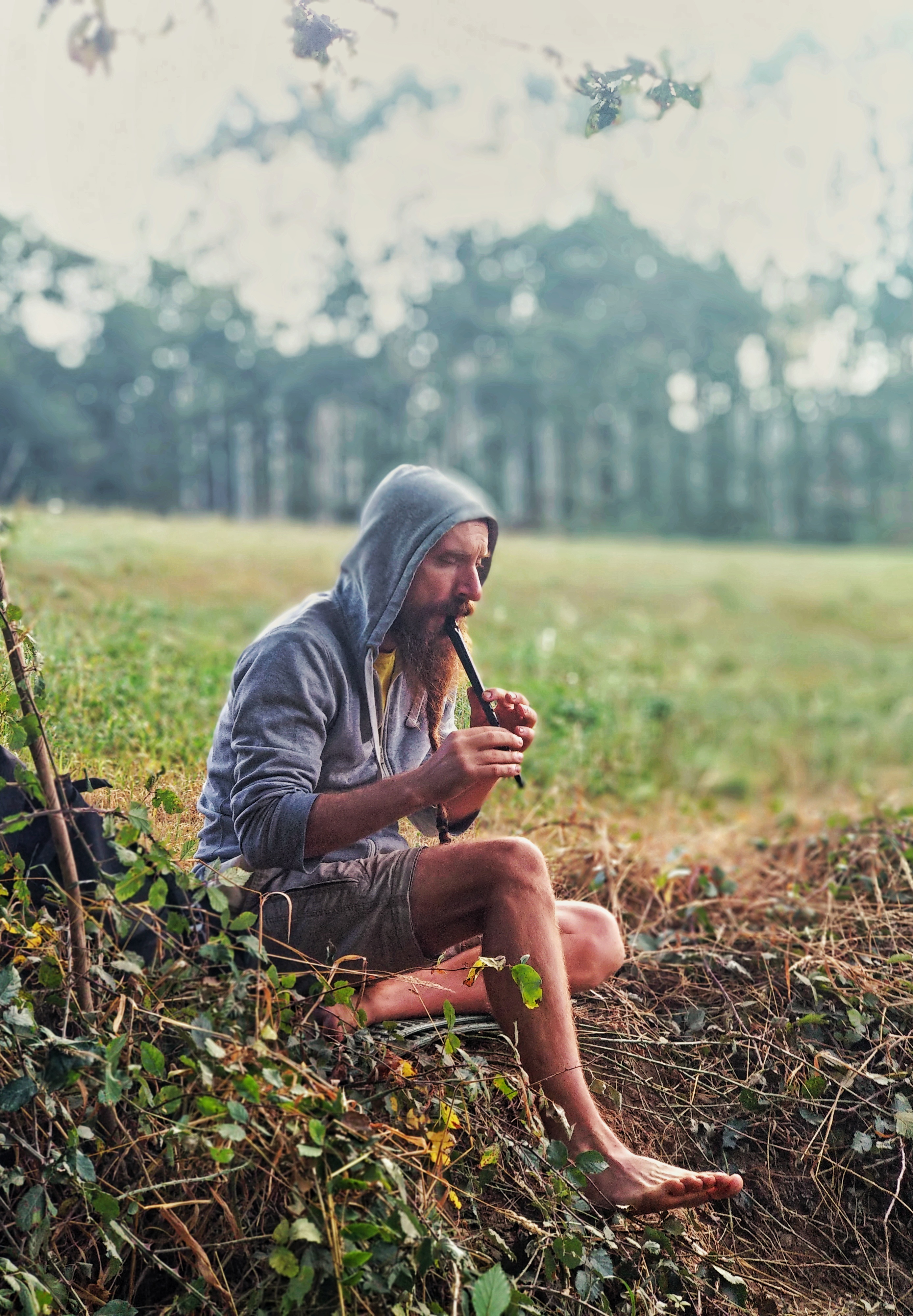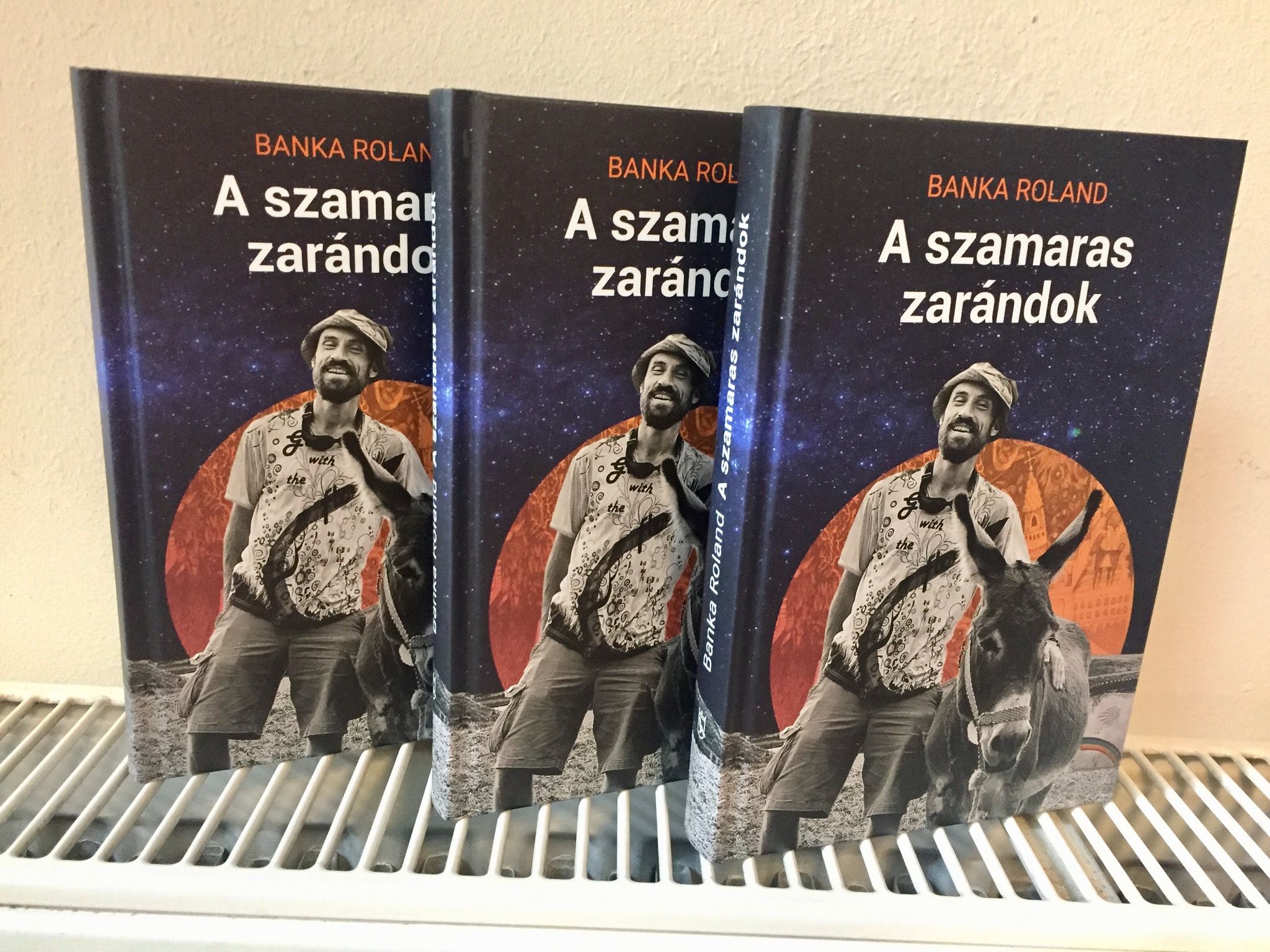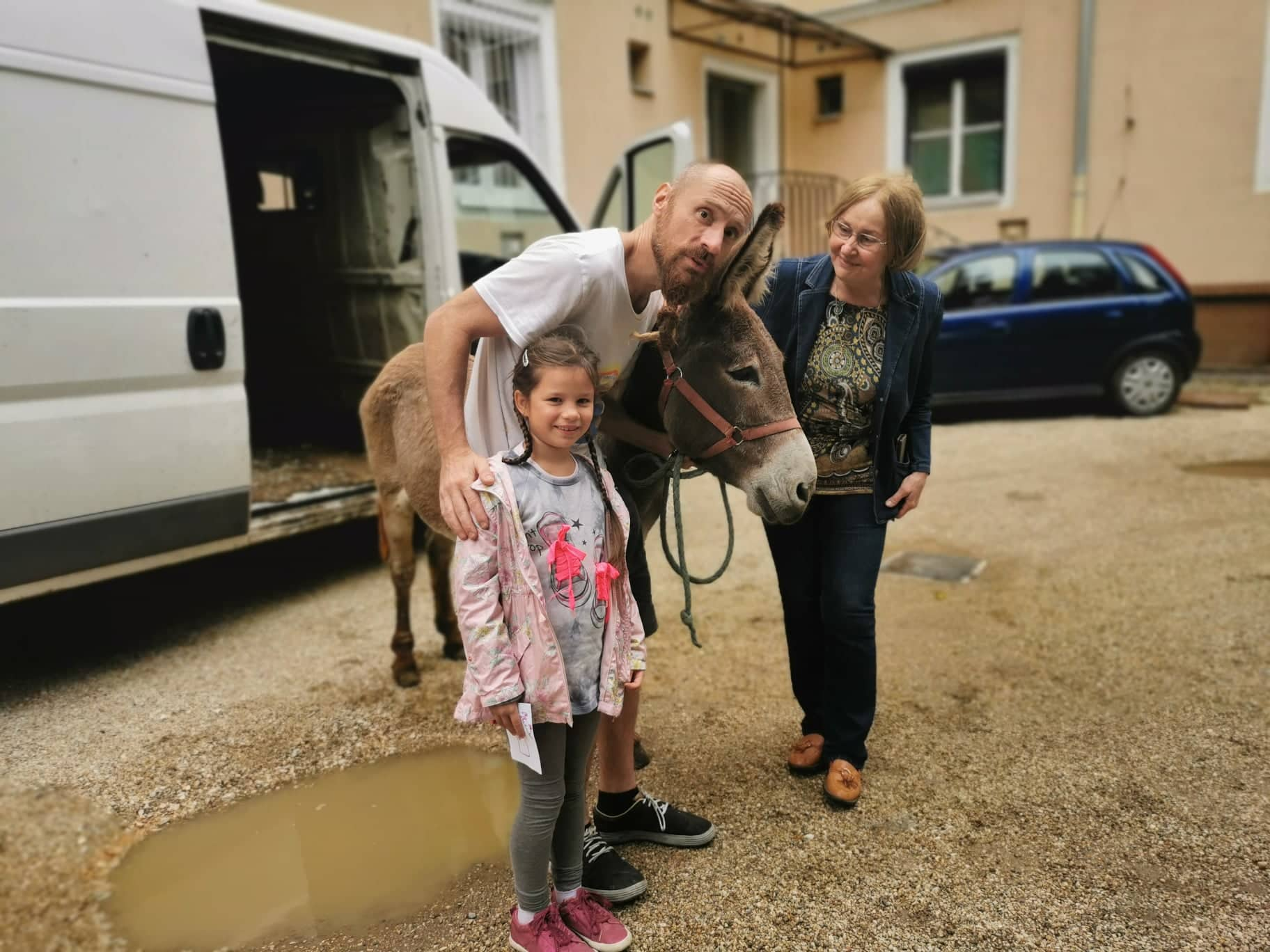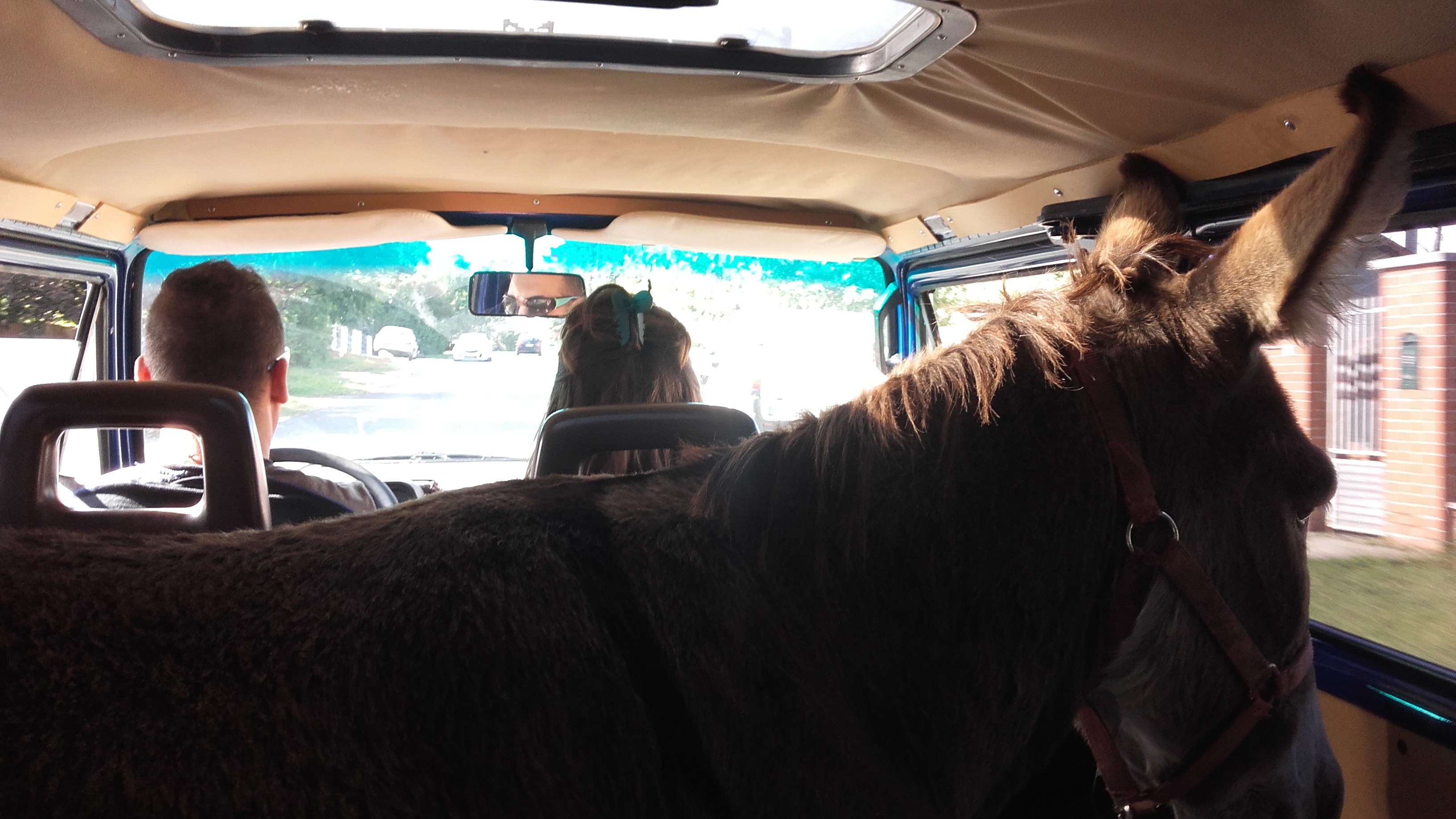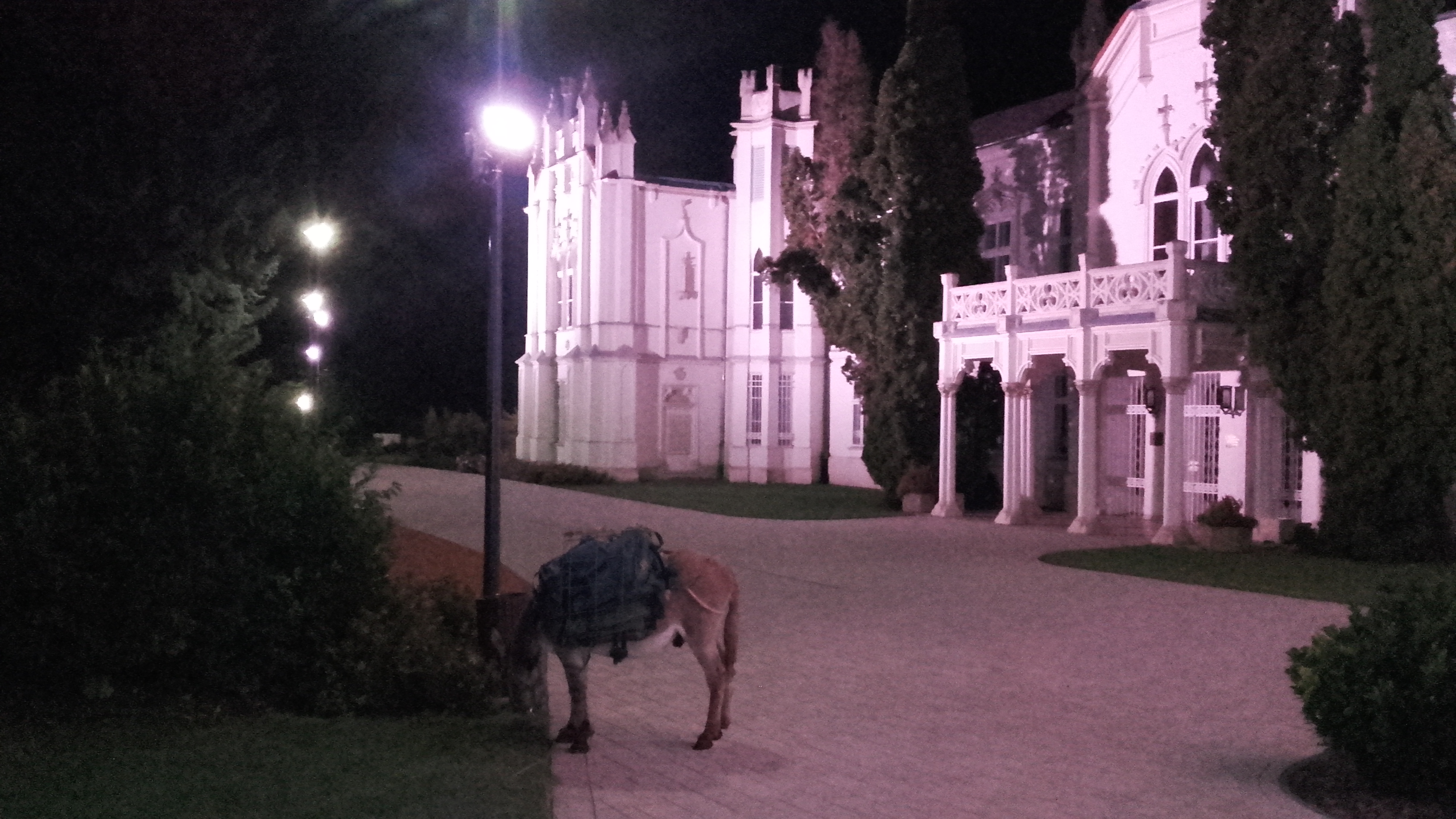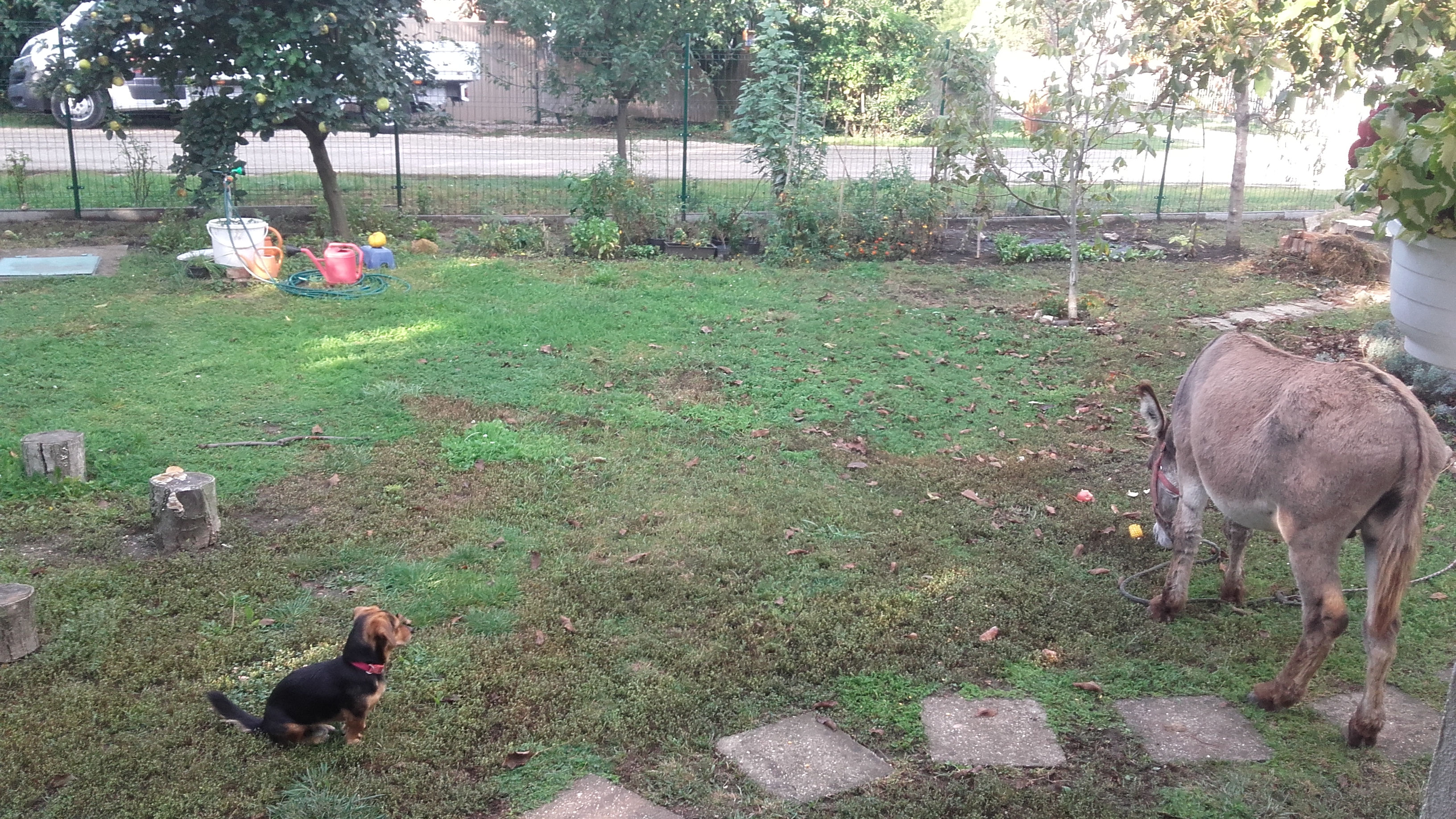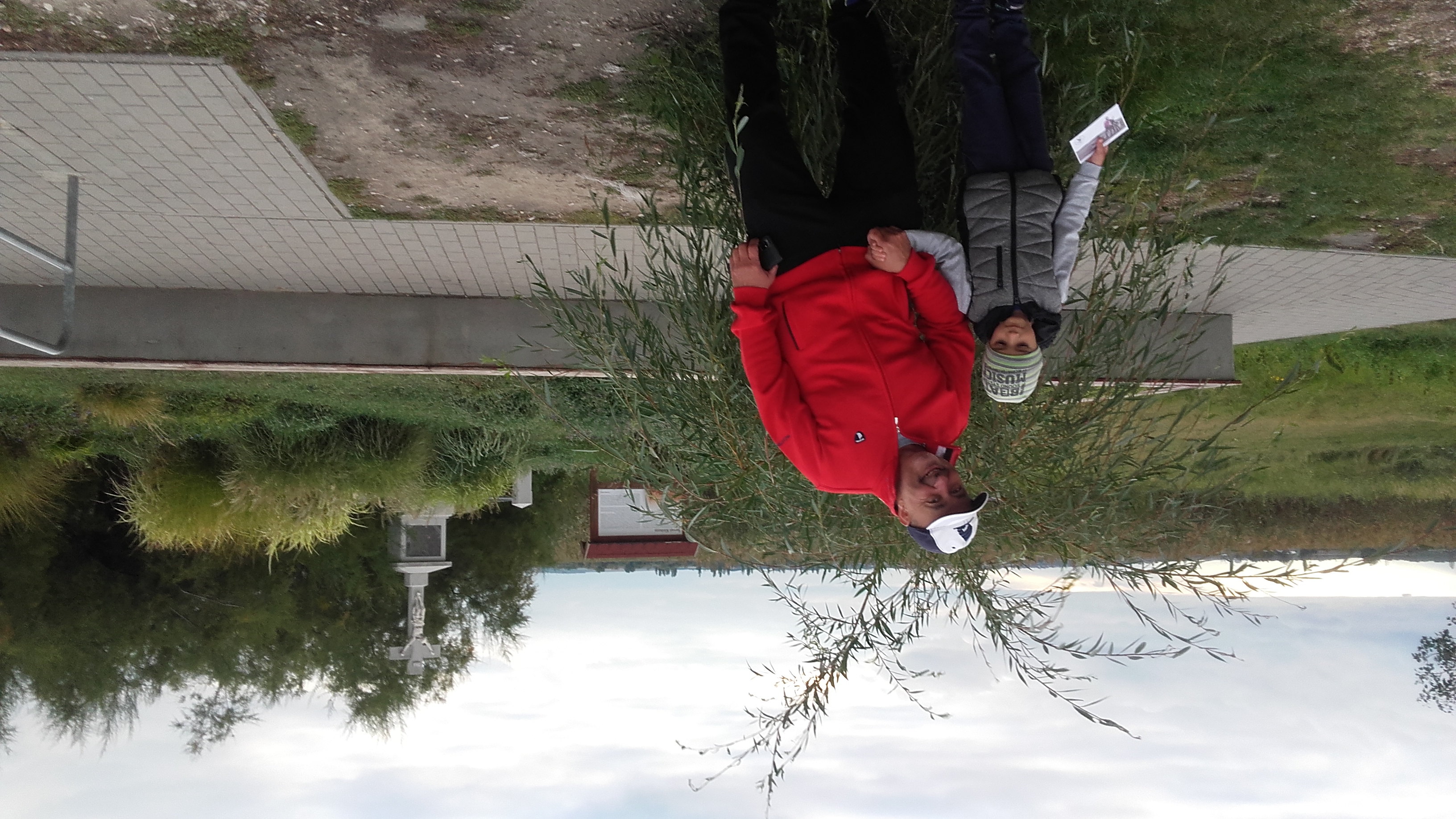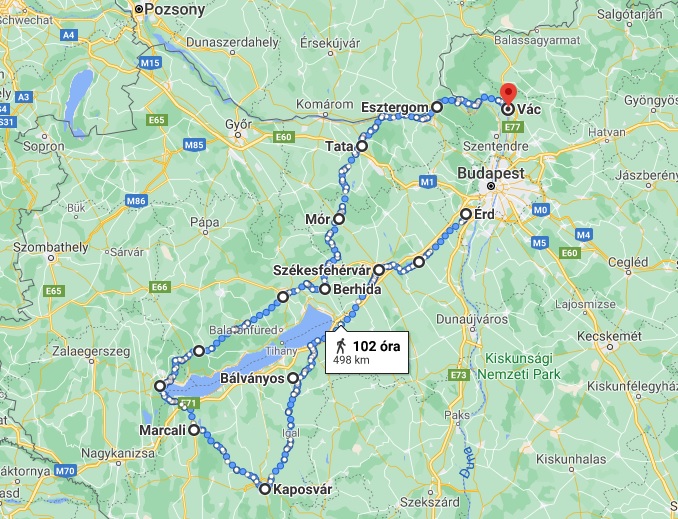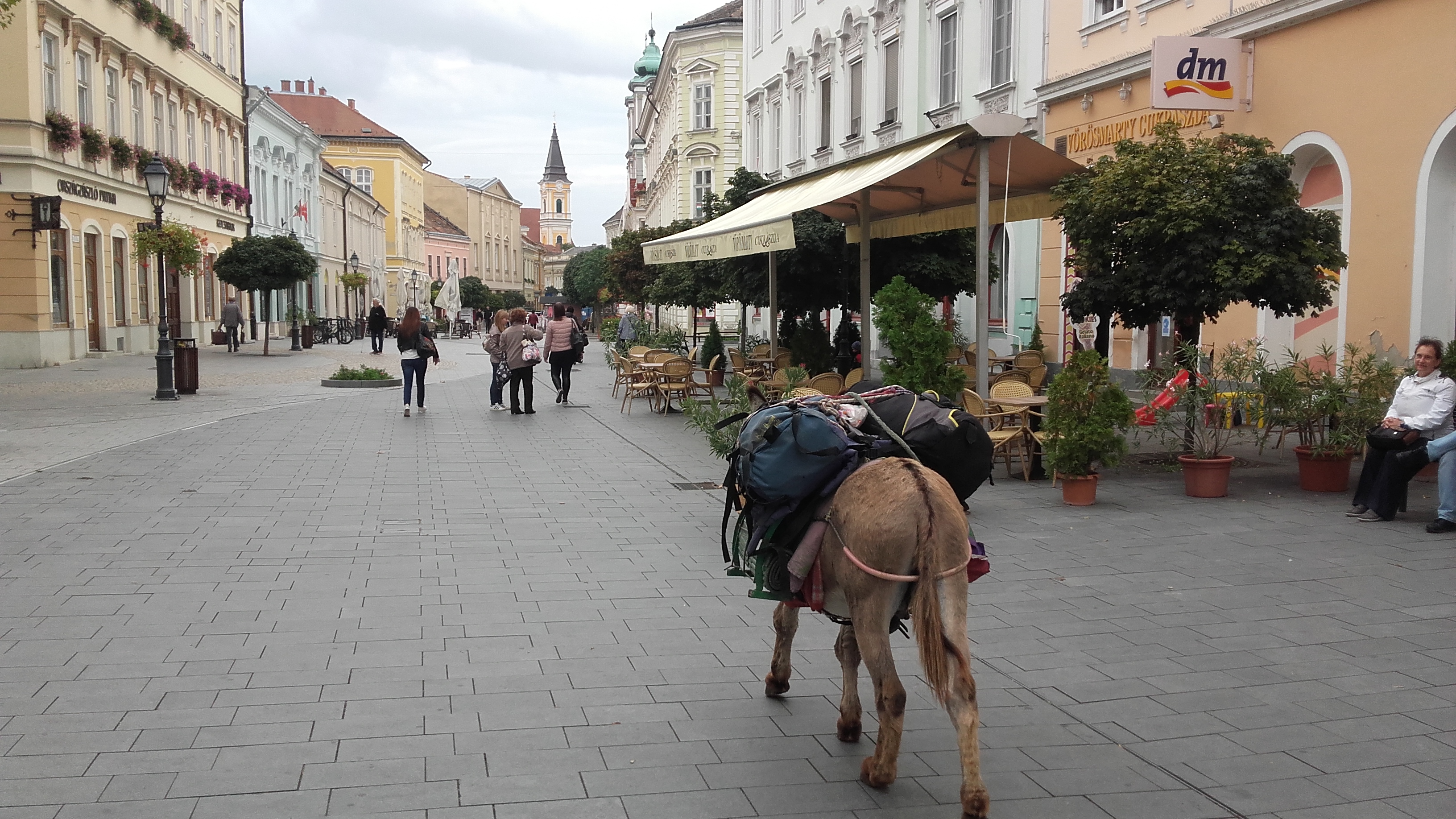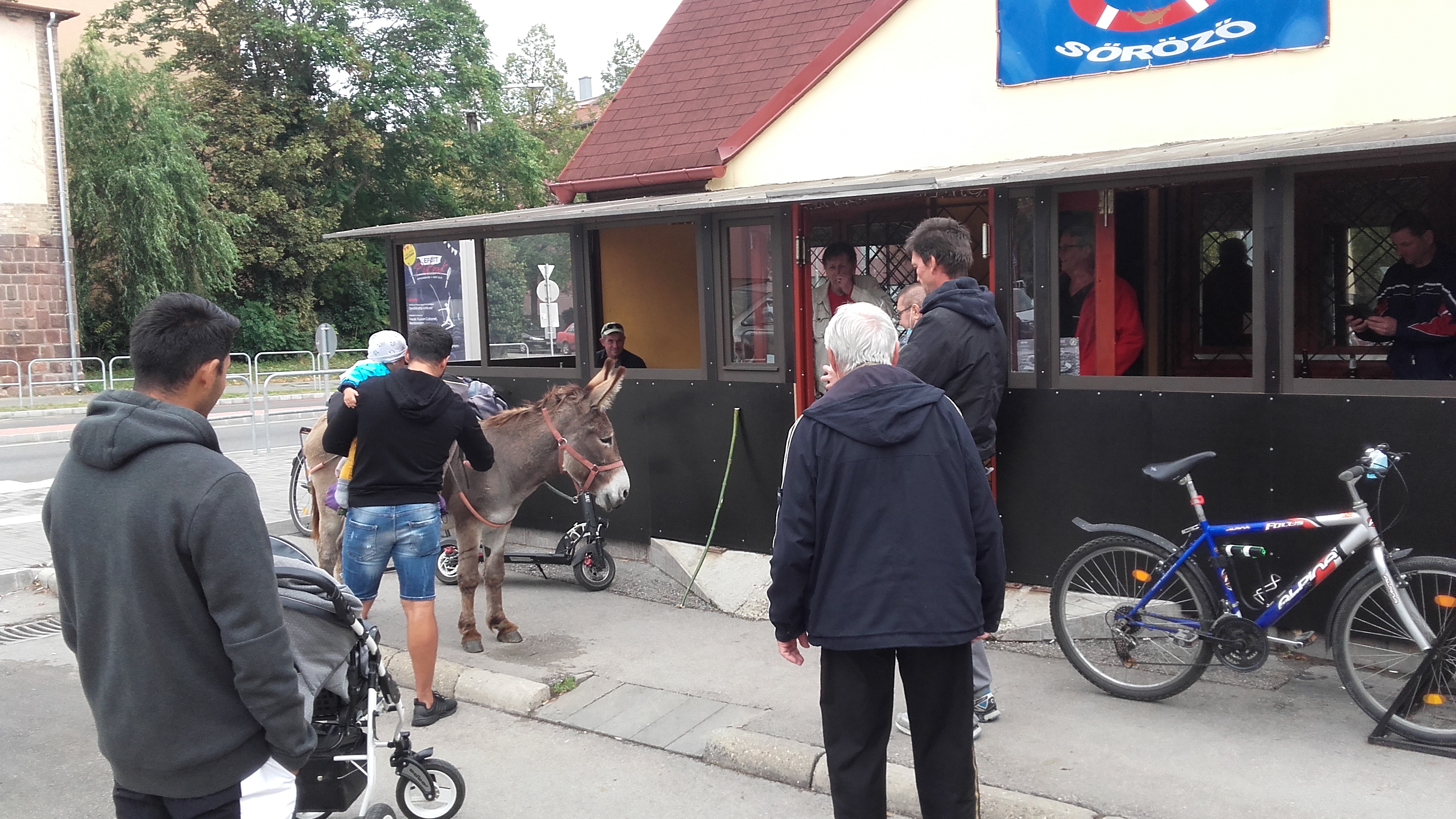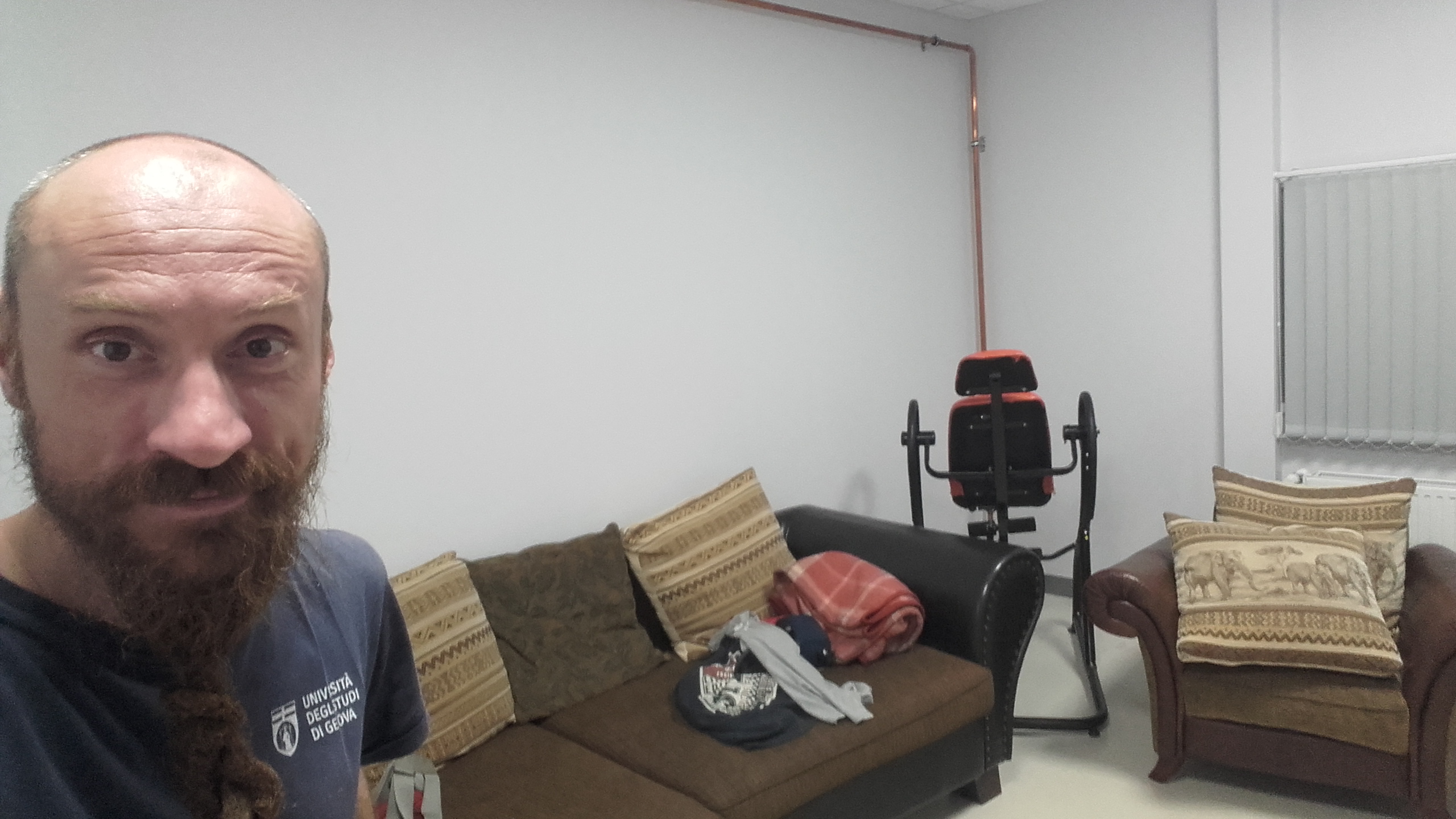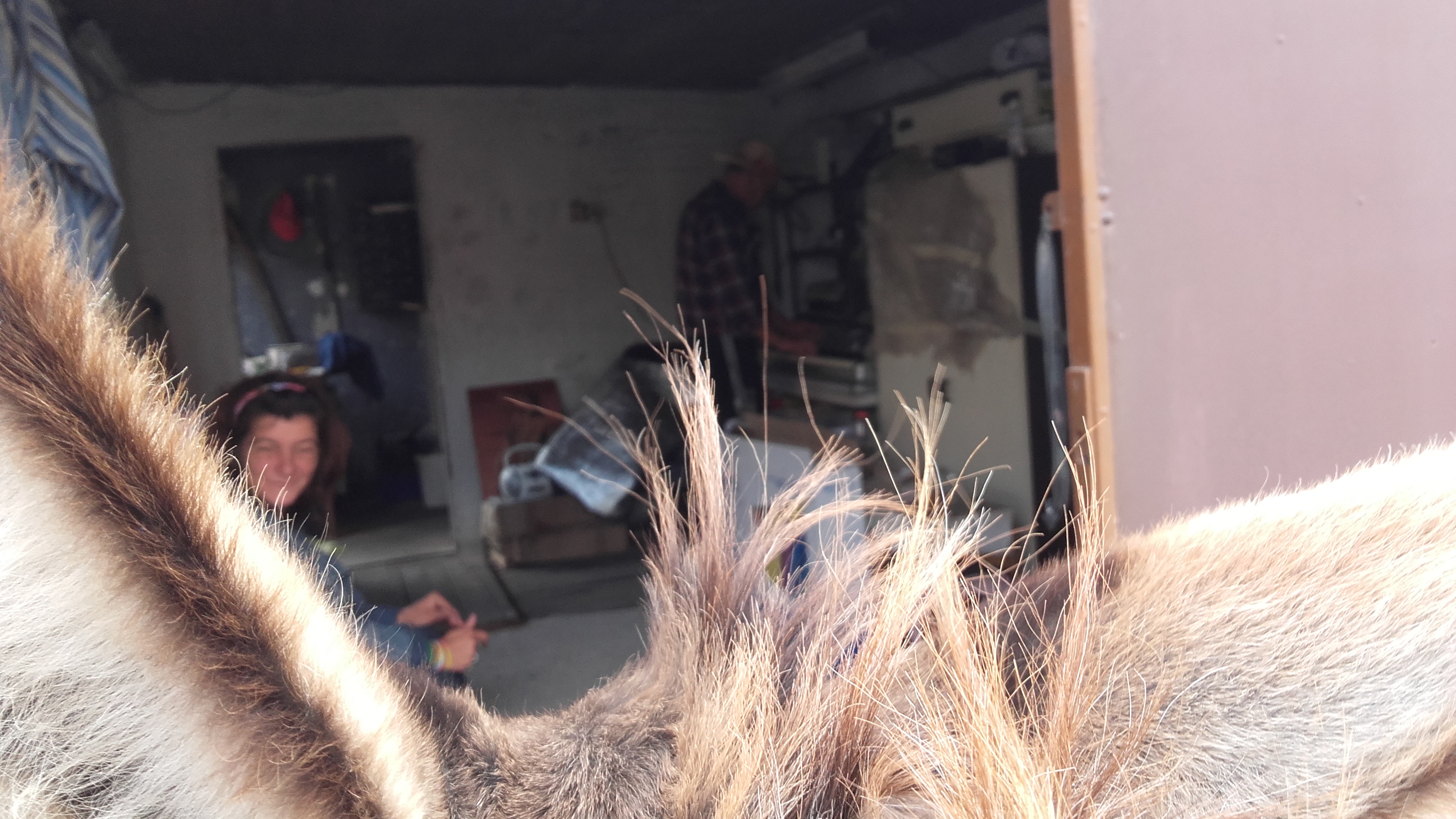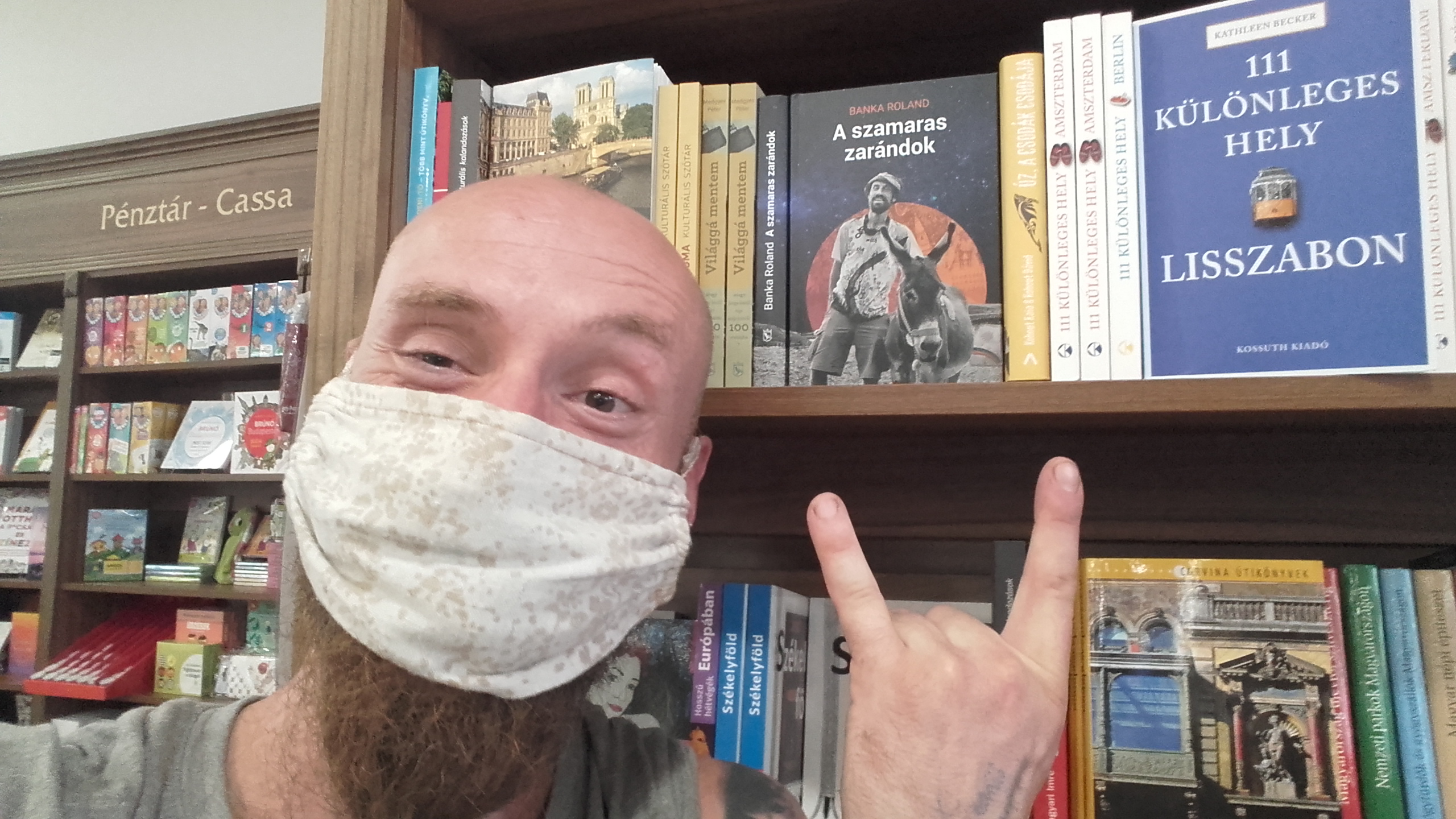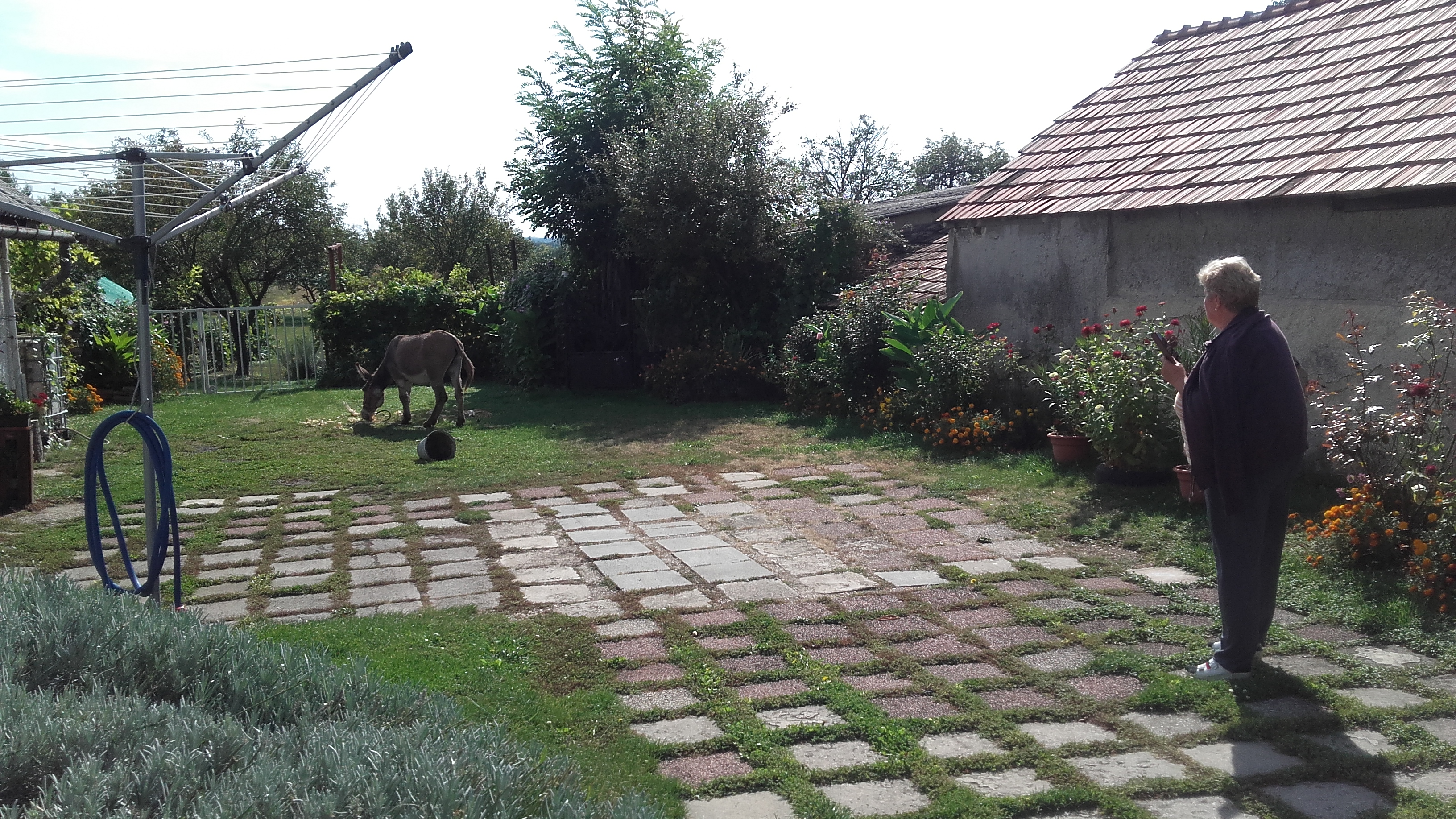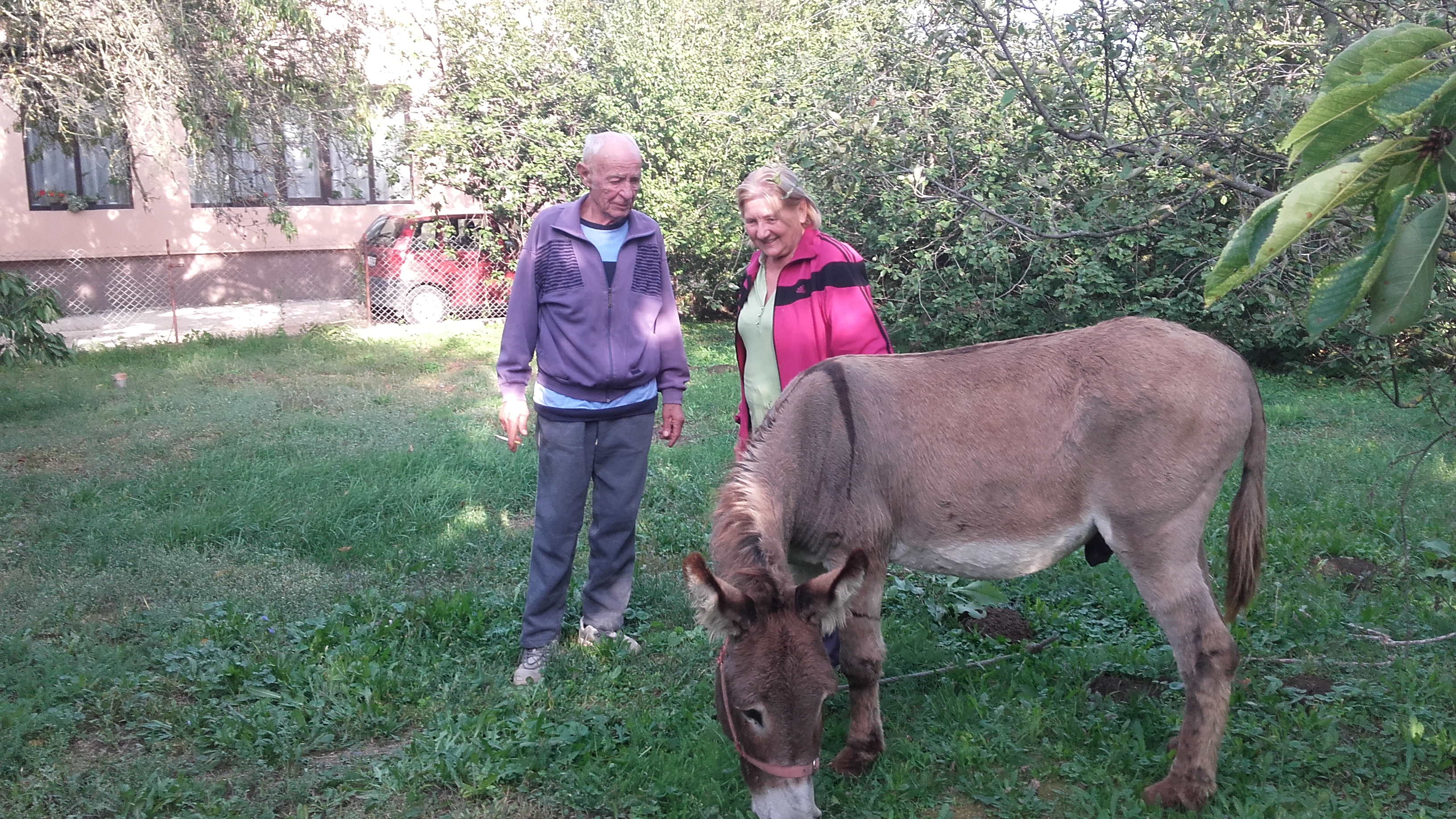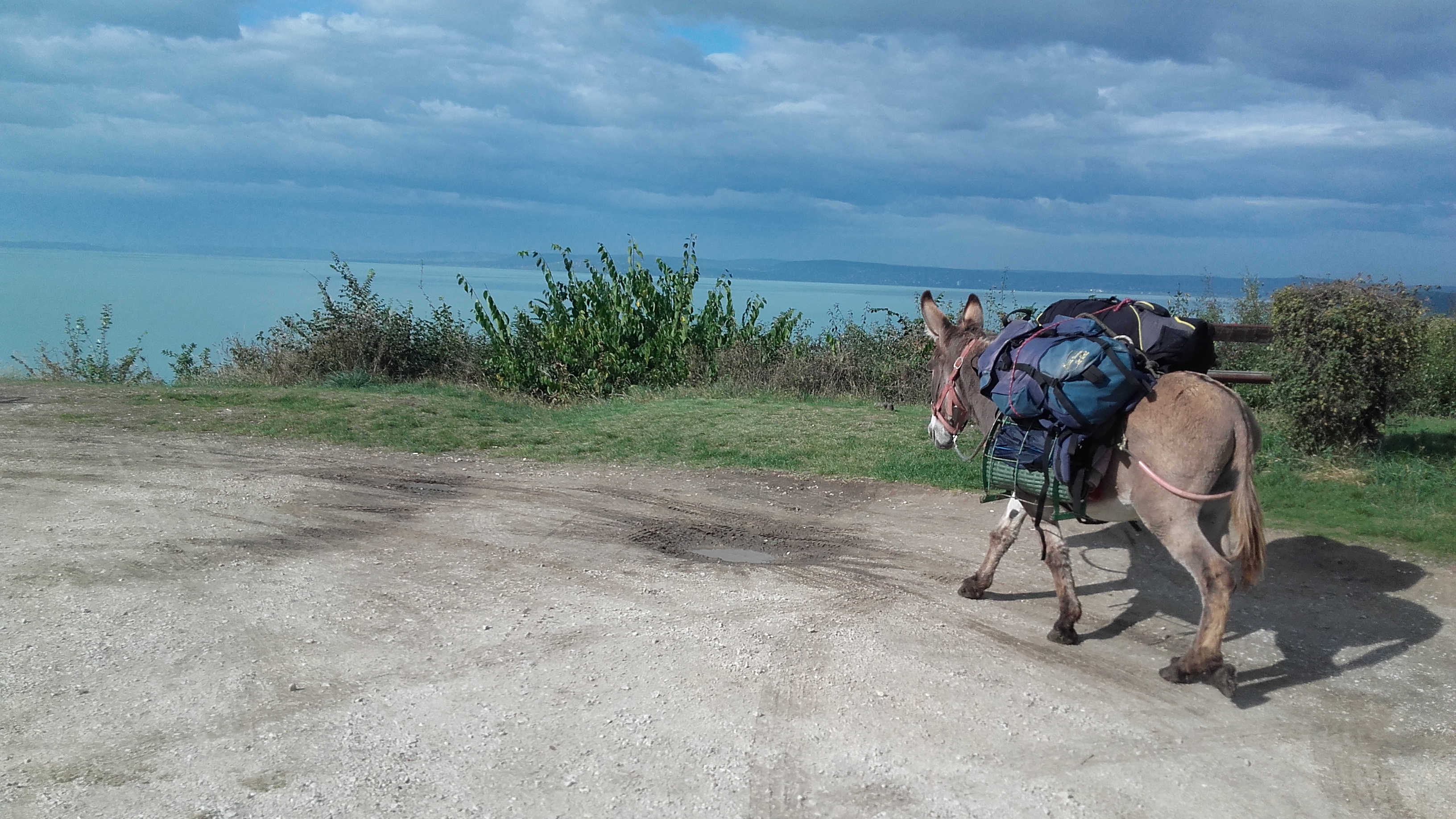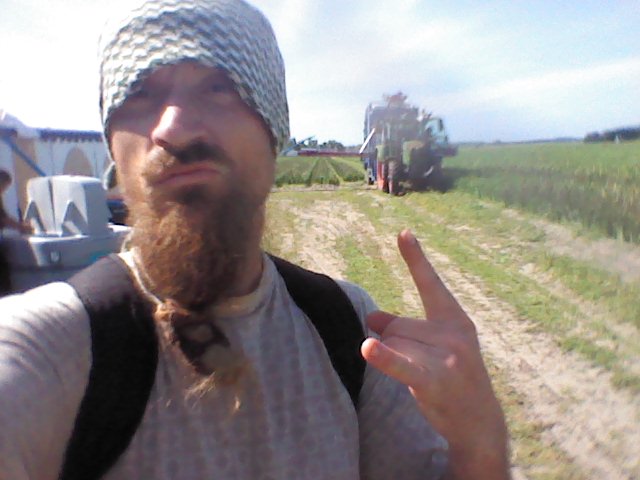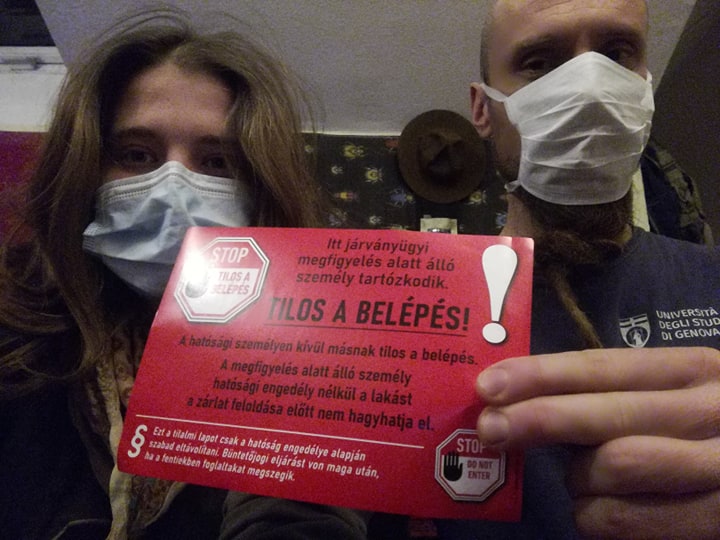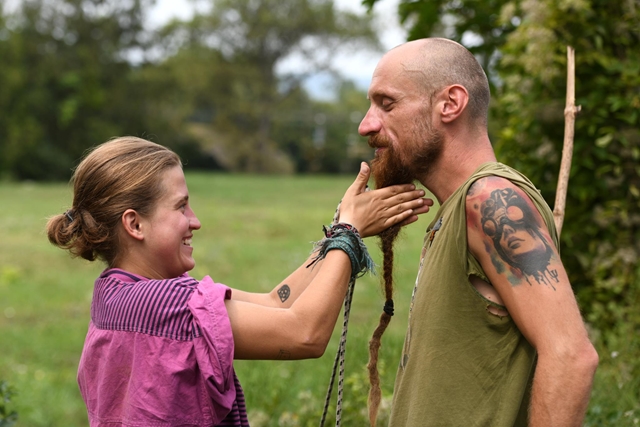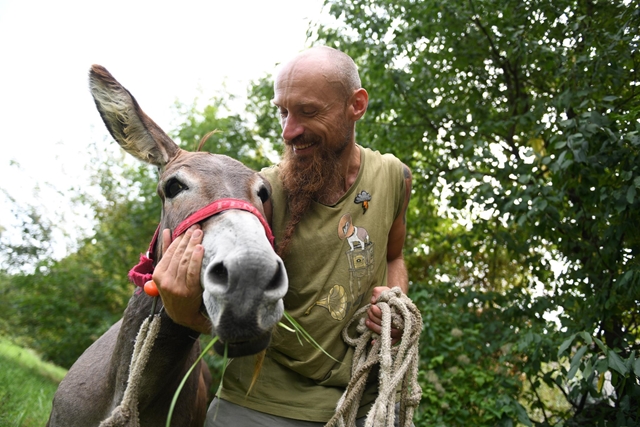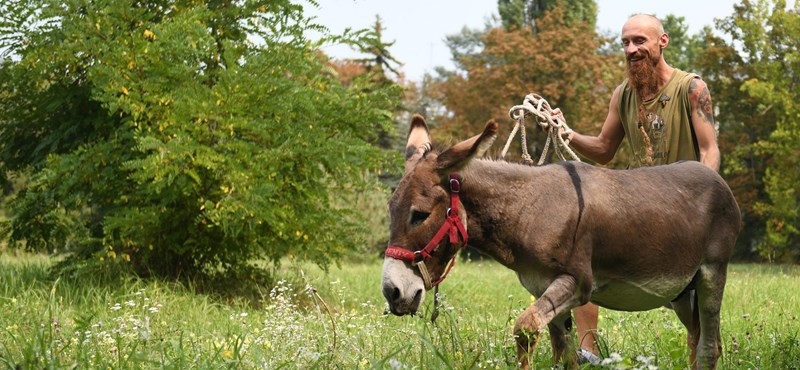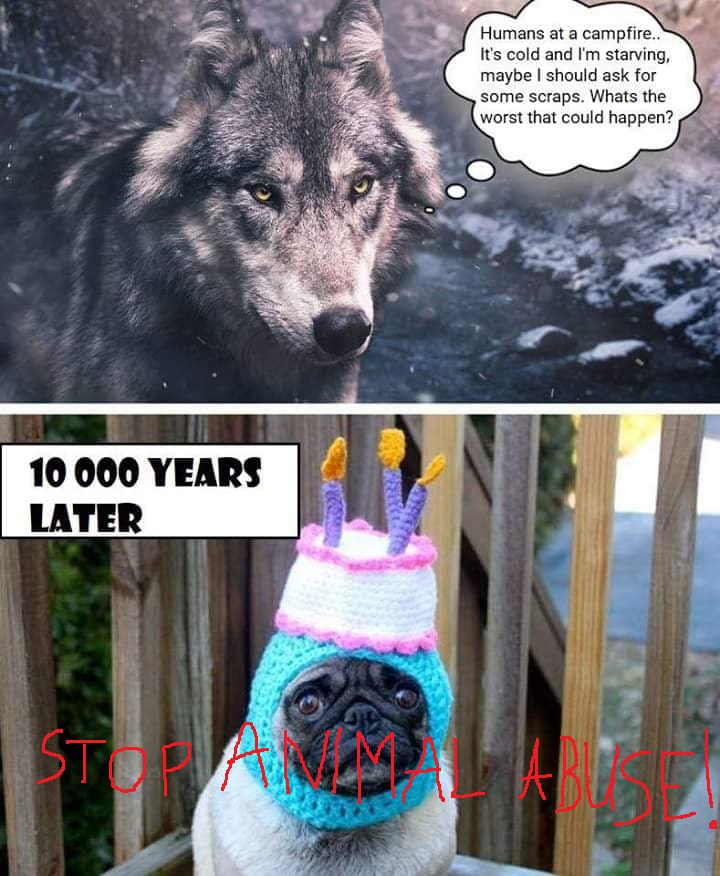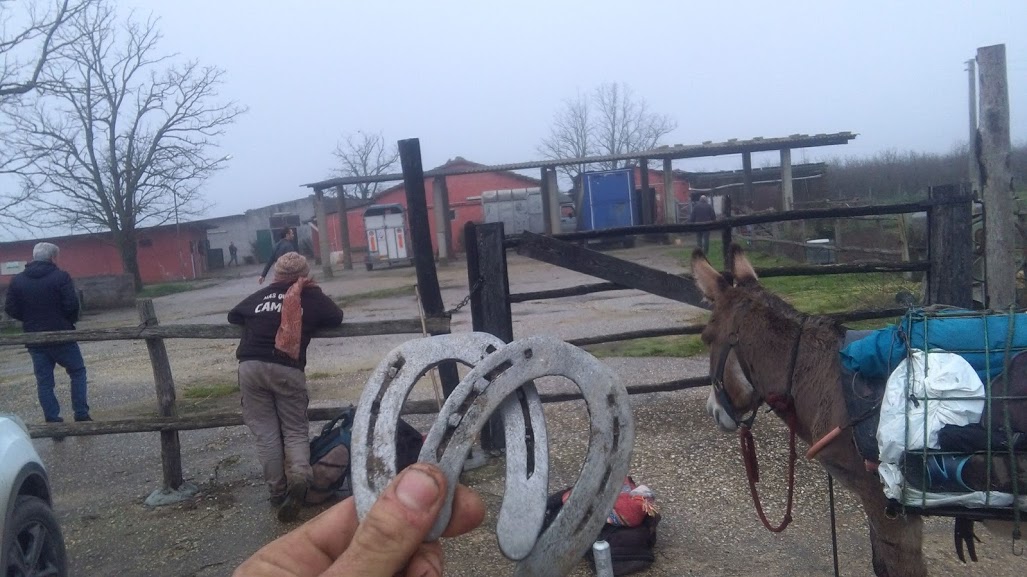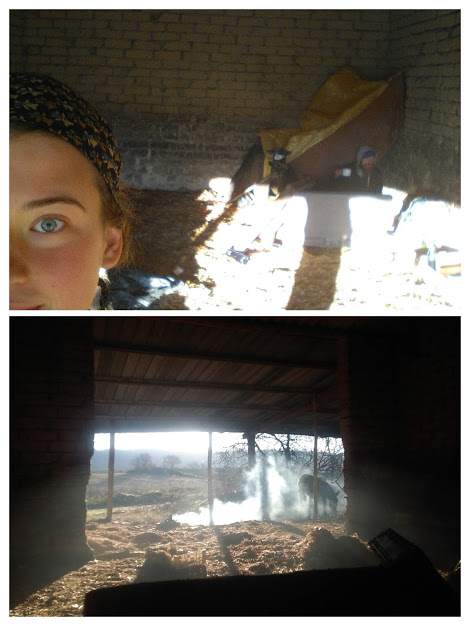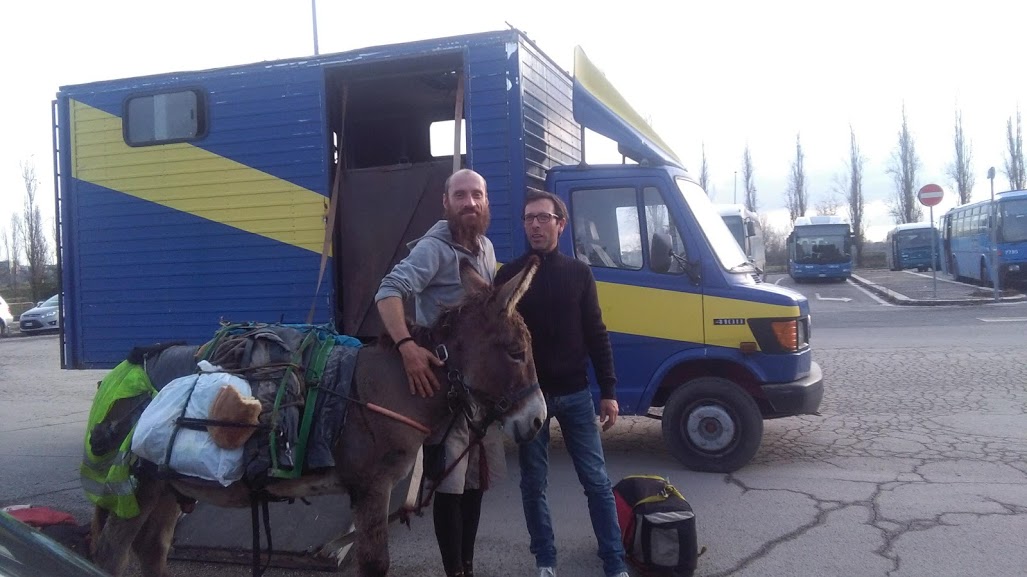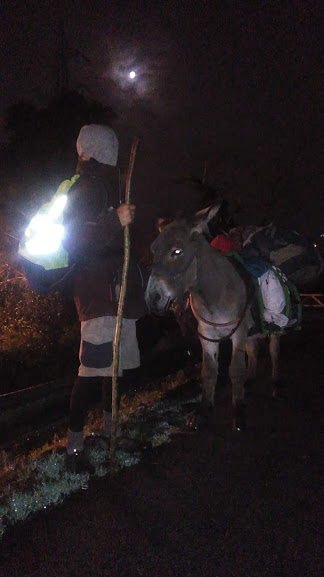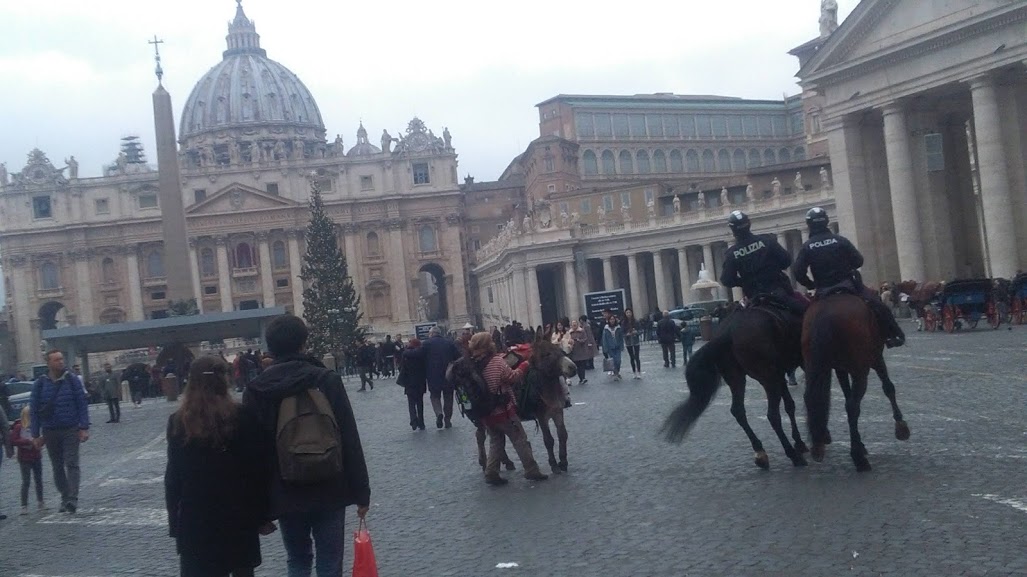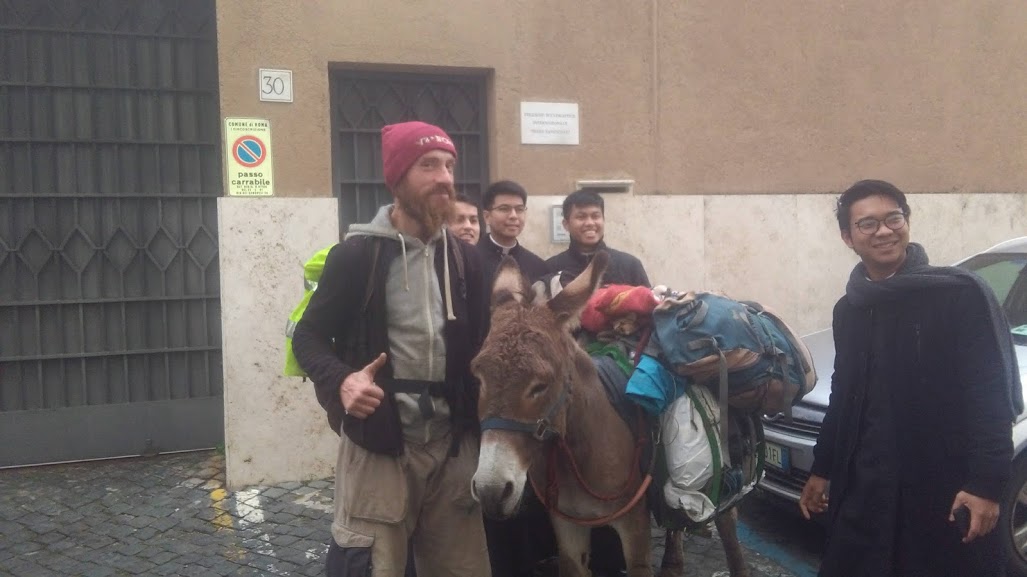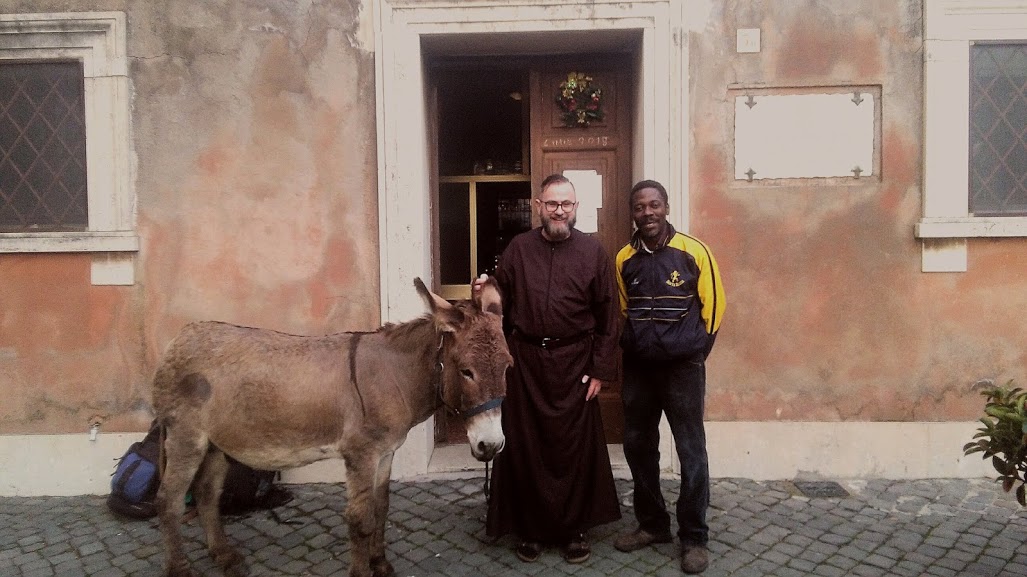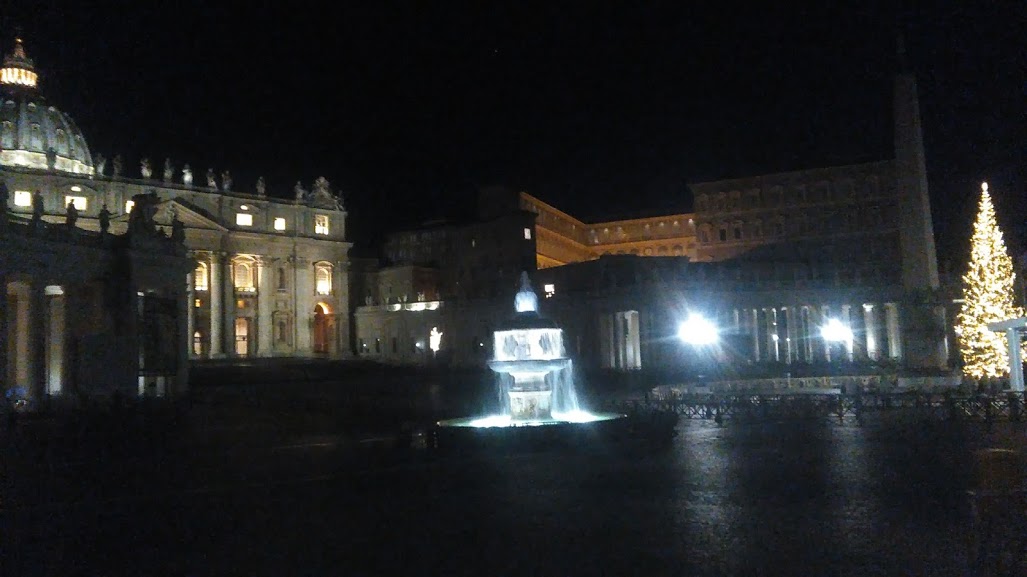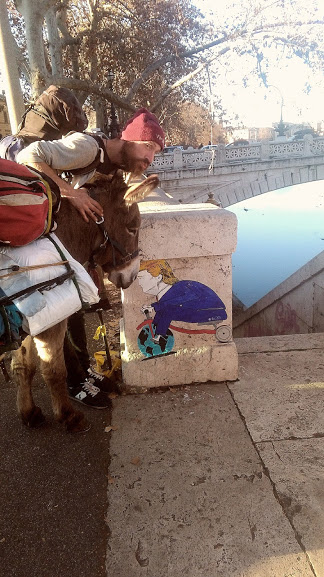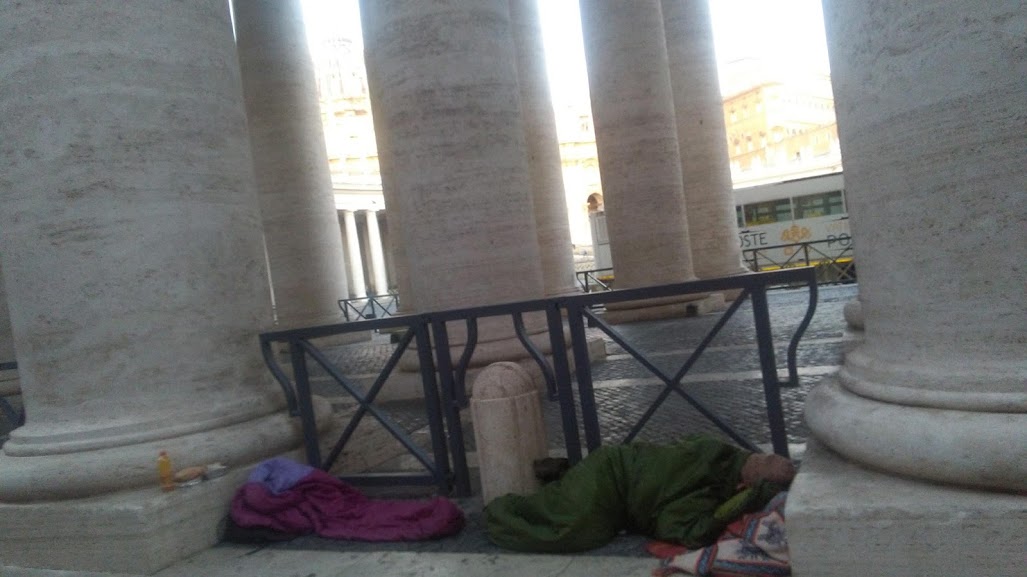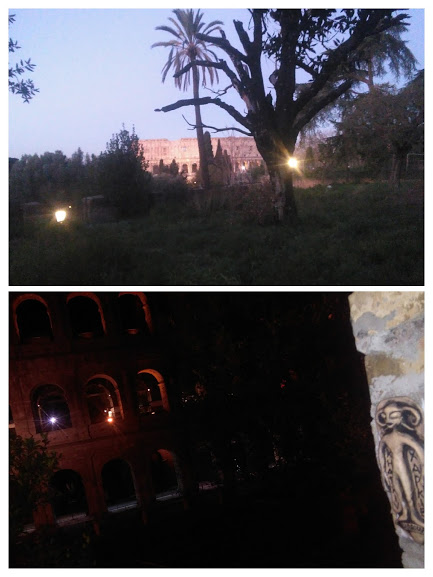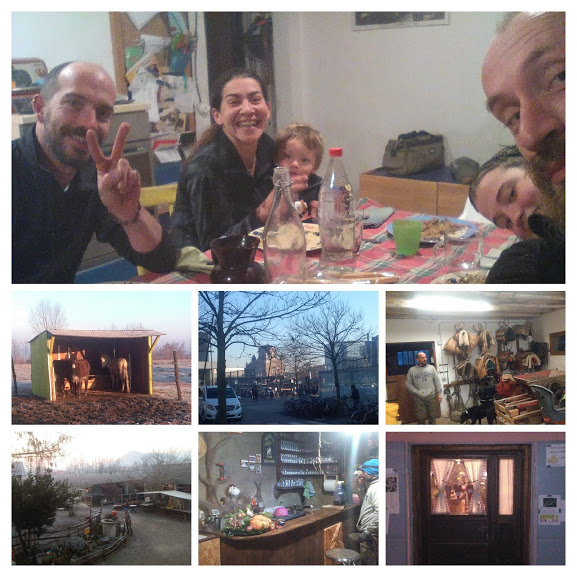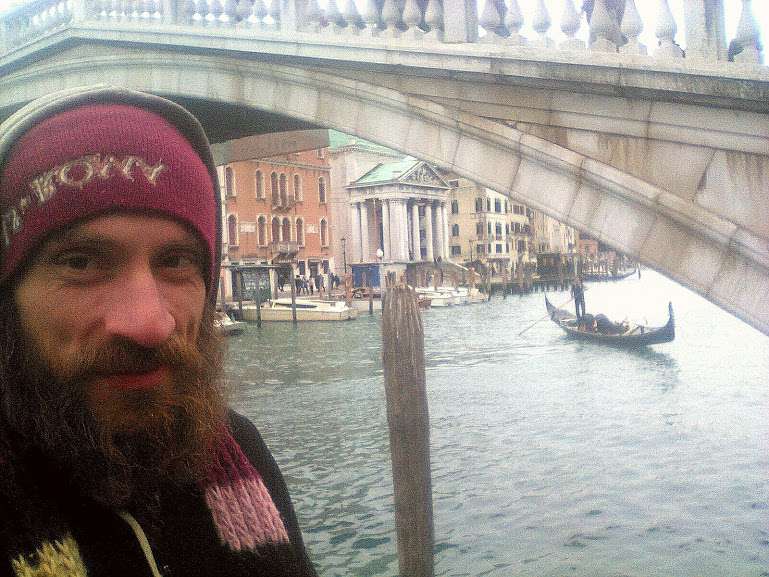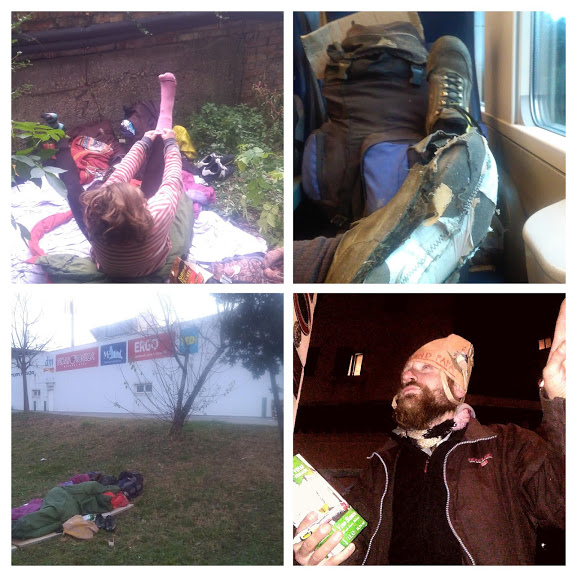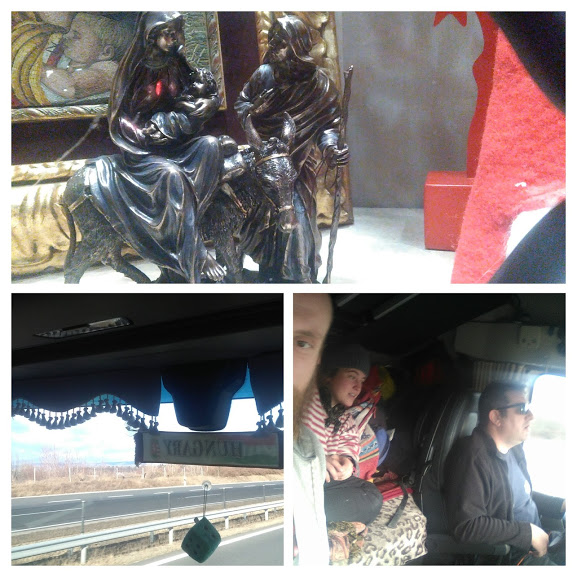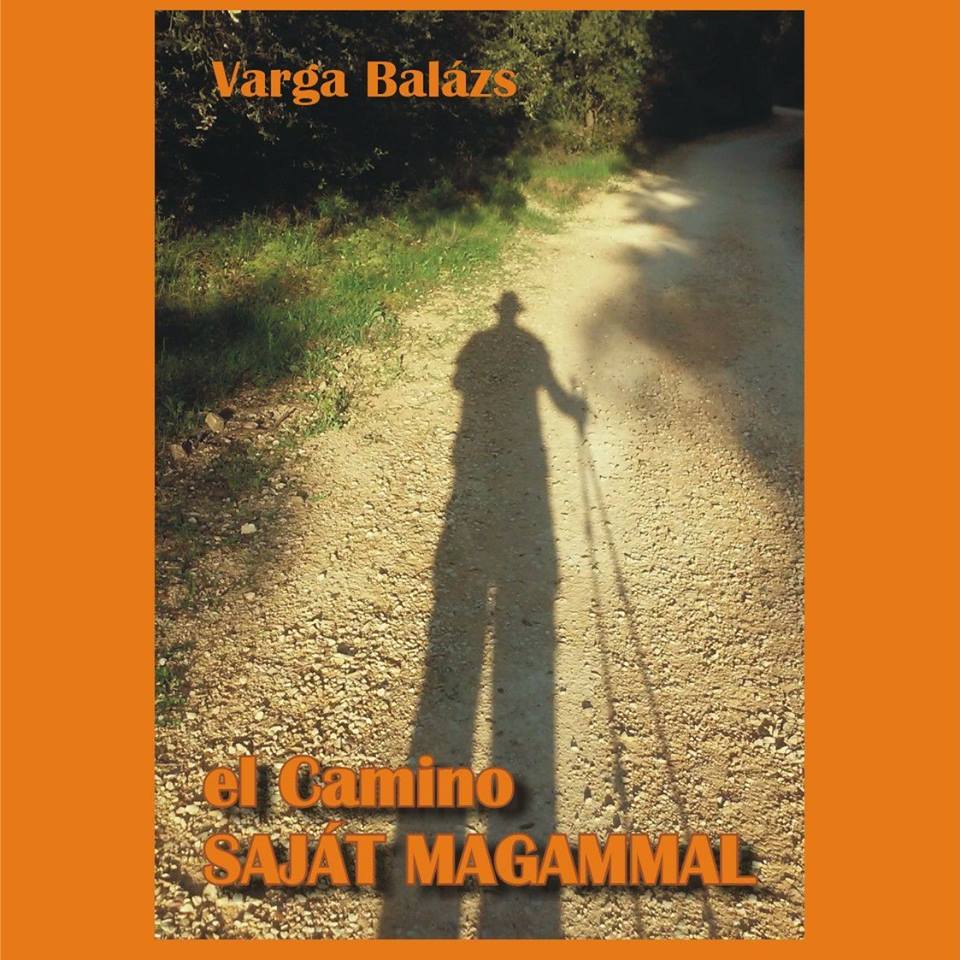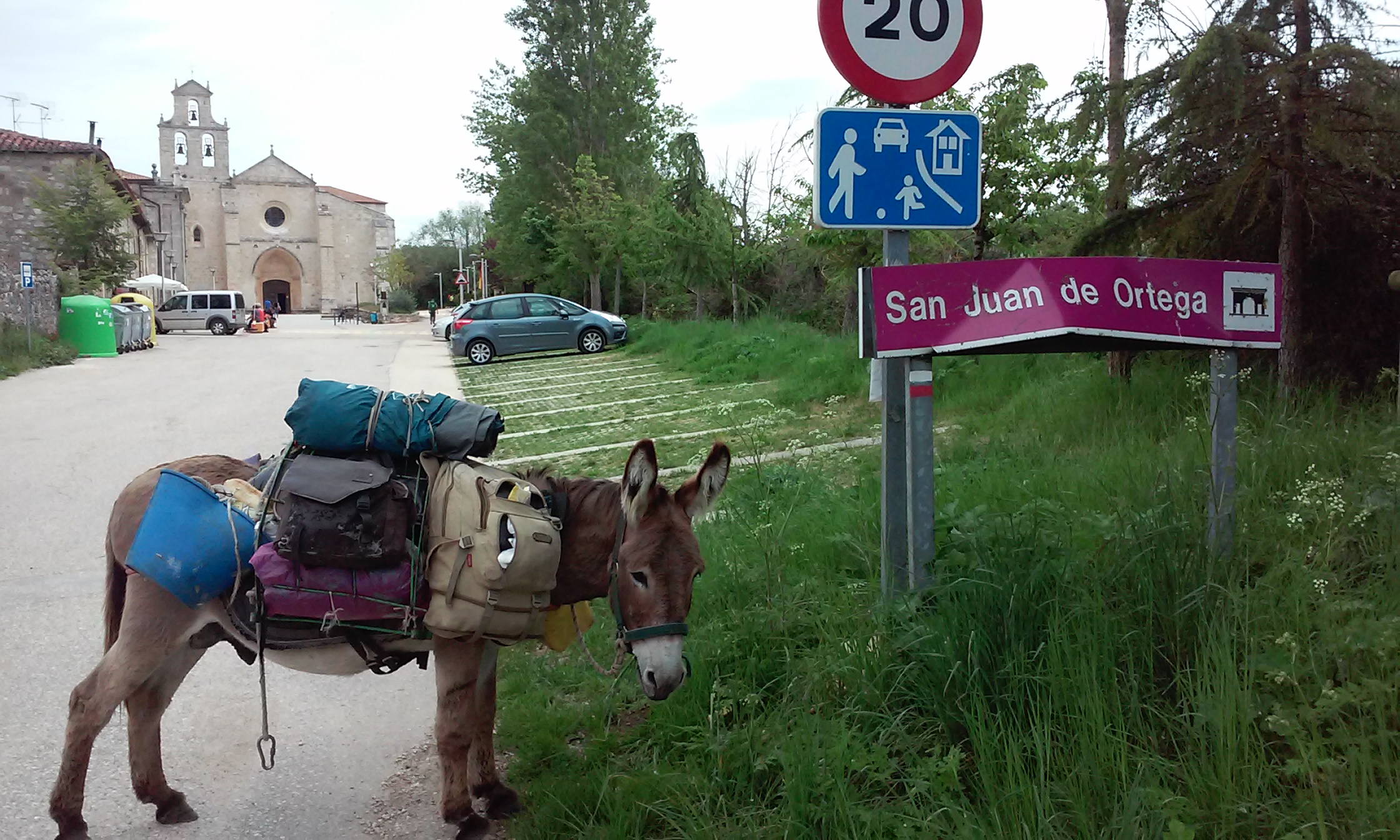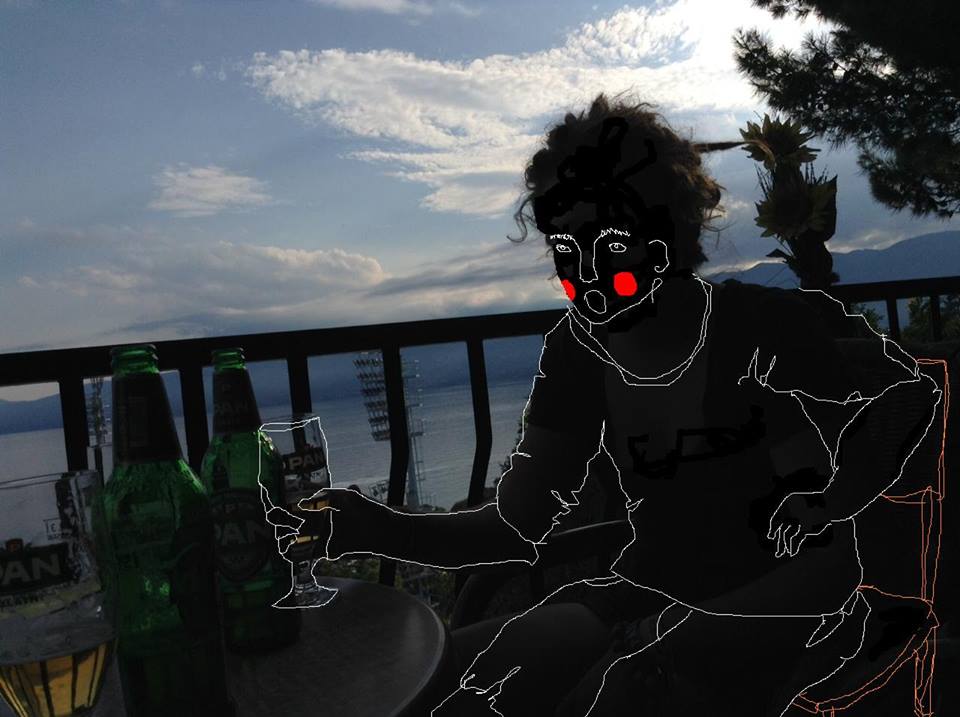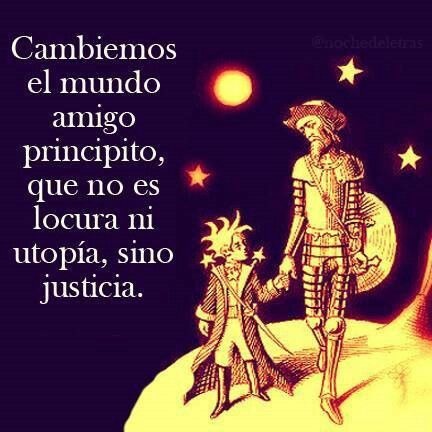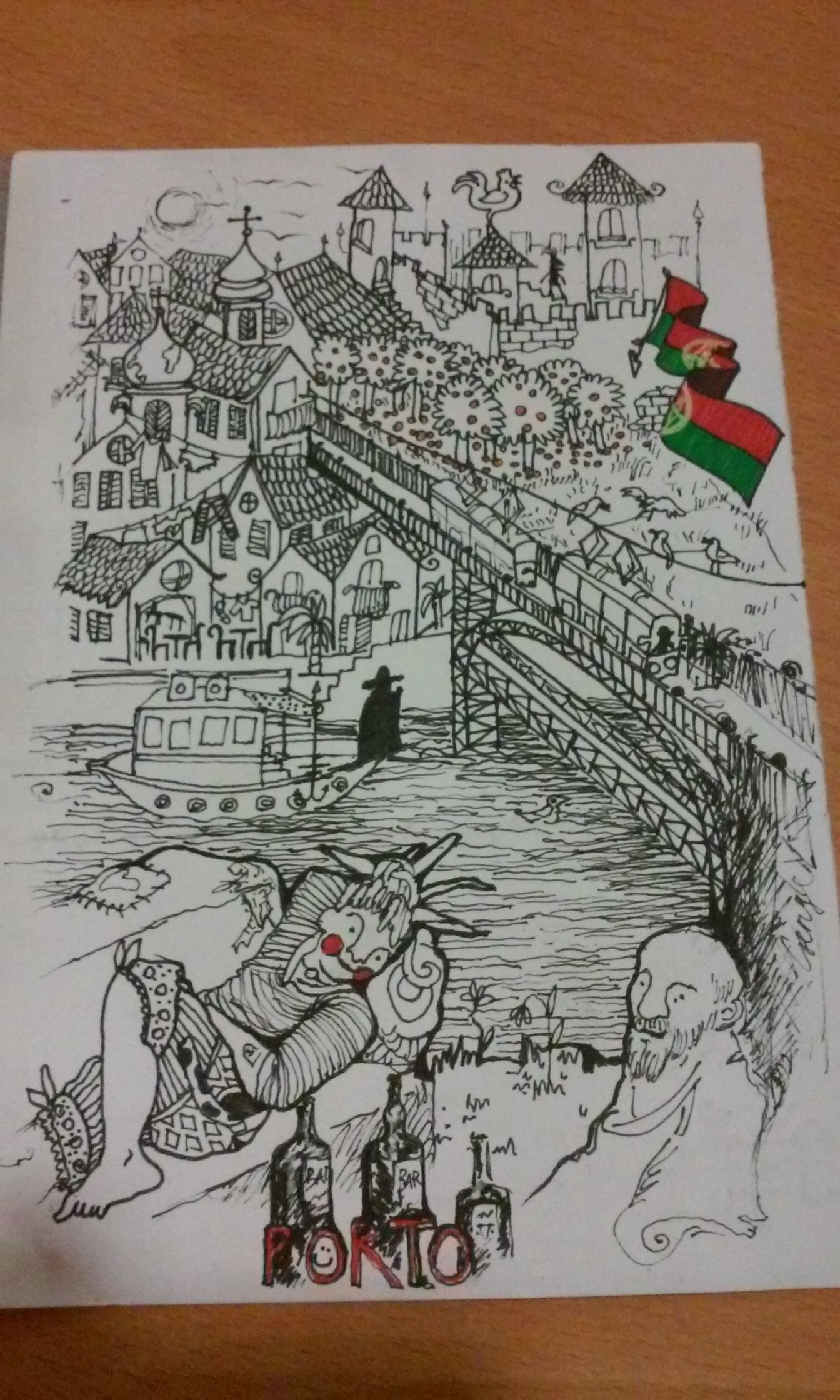HU:
Nem tudom. De el tudom mondani, hogy én mit tettem… Ünnepeljük a blog első szülinapját nagy bulival váratlan bonyodalmakkal és megoldásukkal a Camino Portuguese-en!
Az 1. részben megfantazmagorizálom (akkor is, ha nem létezik ilyen szó!), hogyan képeződhettek le lelki tényezők egy abszurd és valószínűtlen szituációvá, amiben odalett az összes pénzünk és a cuccaim. A 2. rész földhözragadtabb lesz: az eset megoldási procedúrája a helyi rendvédelmi intézkedések és a szociális ellátórendszer – helyenként nem kevésbé abszurd – élményén keresztül.
Szokták kérdezni, hogy hányszor mentem végig a Caminon, és én ezt régebben tök hülye kérdésnek tartottam, holott – mint pedagógusi példaképemtől, Mr. Garrisontól tudjuk – nincs hülye kérdés, csak hülye gyerek. Azt válaszoltam mindig, hogy nem számolom, csak sétálok… Hülye válasz.
Pecséteket sem feltétlenül gyűjtök a zarándokigazolványba, összesen csak egy Compostelám van, amit a legelső megérkezésemkor kaptam 2013 novemberében. (Utána egyszer kértem még ilyen oklevelet 2015 végén a 90 éves nagymamám nevére – fel lehet ugyanis ajánlani olyan személy javára, aki már meghalt vagy nem mozgásképes, tehát nem tudna már zarándoklatot teljesíteni.)
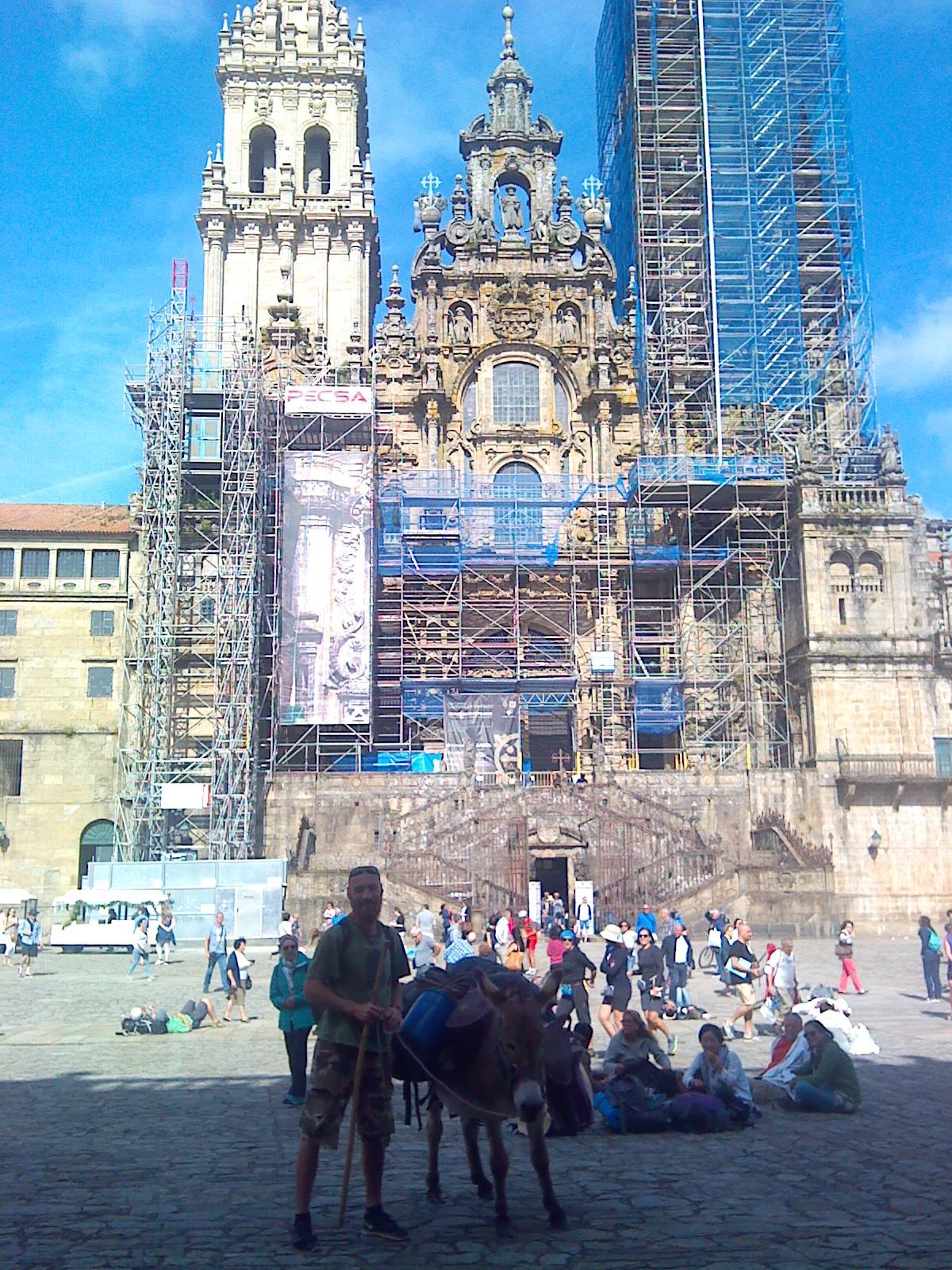
Évekkel az első megérkezés után készült itt rólunk legelőször kép... az állványrendszer alatt állítólag van ám egy templom is!
Átgondolva a dolgot, már nem tartom hülye kérdésnek, és van rá konkrét válaszom is: életemben eddig háromszor teljesítettem a Szent Jakab zarándoklatot. (Hogy mikor-honnan-meddig-hová, lásd ITT: I.1-7., II.2-3. és III.1. pontok.) Persze egy csomószor érkeztem meg 100km-nél távolabbról Santiago de Compostelába gyalog, de háromszor éreztem azt, hogy ténylegesen zarándok vagyok.
Ez az érzés függetlennek tűnik az akaratomtól, csak úgy belezuhanok valahogy, de annyi bizonyosnak látszik, hogy fontos összetevője a komfortzóna elhagyása. Mivel nekem komplett életmódváltáshoz kapcsolódik ez az útvonal, nem lehetek itt folyton zarándok, hisz tulajdonképpen az utat tettem a komfortzónámmá.
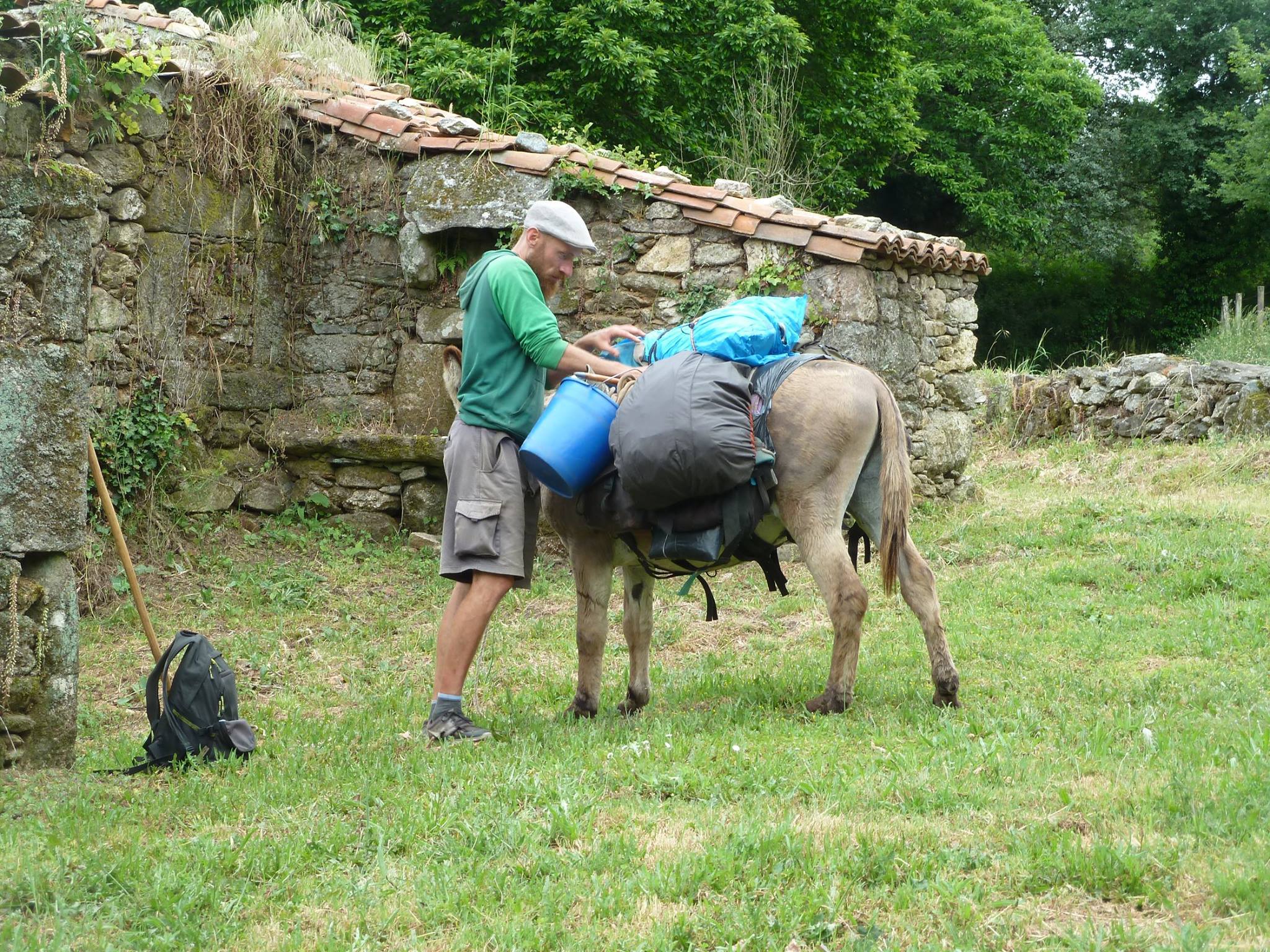
Ahogy most télen Rocinante lenyugdíjazó hazasétáltatására készültem (mondjuk Muxia-Santiago-Lourdes-Róma-Assisi-Medjugorje-Budapest-Szentendre vonalon két részletben, kb. kétszer 5 hónap alatt), combosodott bennem otthon az igény egy negyedik caminora – töltekezésre a sokszorozható és továbbadható lelki adományokkal. Feldobva és ráhangolódva szerettem volna nekiindulni a végeláthatatlannak látszó nomád missziónak.
Az újdonságot ill. a „komfortzónán kívüliséget” ezúttal az új ország, azaz a derűs Portugália, és a szamár hiánya, azaz a teljes februári egyedüllét adták volna – ahogy én azt elképzeltem. Beköszönt viszont szamár-hazasétáltató partnernek Csenge, aminek igen örültem, mert kétszer 5 hónap magány egyben azért riasztott. A helyzet úgy adta, hogy az a legpraktikusabb, ha már Portóba is együtt megyünk. Így aztán elsőre ő is a mezei zarándok szemével néz majd az Útra: normál irányba tartva, csacsibónusz nélkül. Február 19-én érkeztünk a városba...
Nem szállt meg a zarándokérzés Portugáliában. Hiába mondom én saját magamnak is, hogy független az akaratomtól. Megszállt egy csomó más, és király is volt! Csak nem volt Szent Jakab zarándoklat.
Mesélek róla.
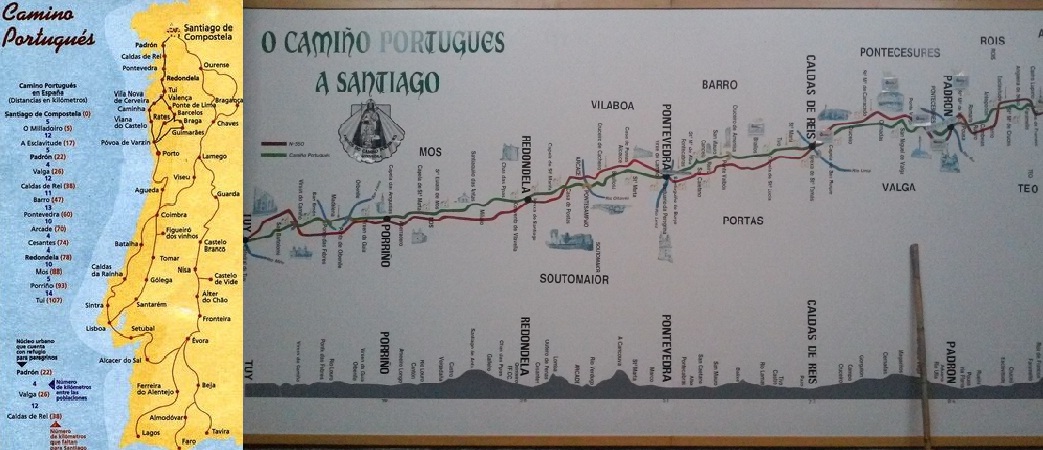
Camino Portuguese és külön a spanyolországi szakasza (a pontevedrai Albergue Municipal faláról)
Marha sok cuccal mentünk – megint csak praktikus okokból, gondolva a későbbiekre. Marha kemények is vagyunk, úgyhogy kezeltük a problémát… Igyekeztem út közben kitenni ezt-azt e blog fézbuk oldalára, után lehet követni portugál napjainkat – például túráinkat az újrahasznosított babakocsival, amikor pár napra én váltam szamárrá:

Valójában még ki is fejeződött az igény már Portóban, hogy bárcsak ellopnák a cuccainkat, és akkor szabadon flangálhatnánk tovább: egy helyi csöves mutogatott egy csomagmegőrző szekrényt az állomáson, hogy oda rakjuk a táskáinkat, mi meg oda is raktuk. Gondolkodtunk utána, hogy miért ilyen kedves ez a szakadt, piaszagú bácsi – csak nem tudja annak a széfnek a kinyitási módját?! Nem, önzetlenül segített, sajna" vehettük vissza hiánytalanul a terheinket.
De az út gondoskodik, ahogy mondani szokták; csak hát mikor mit, kiről hogyan – mondom tovább.
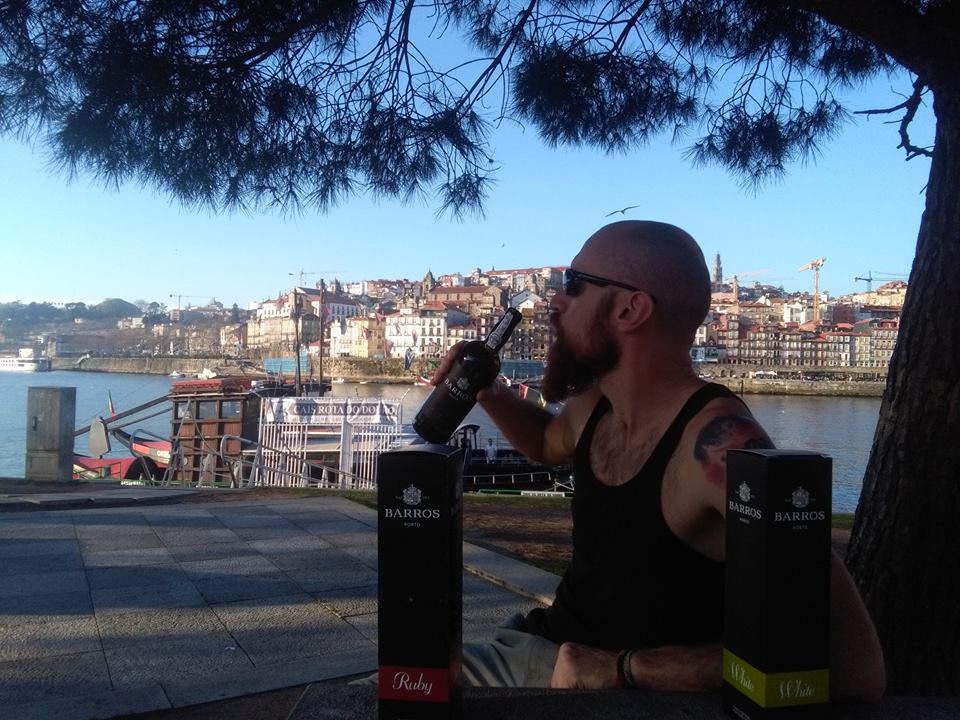
Vinho do Porto, gondtalanság
Viszonylag zökkenőmentesen értünk el Spanyolországig a mi low budget üzemmódunkban, volt viszont egy konfliktus köztünk, ami fontosnak tűnik a továbbiak alakulása szempontjából.
Nekem elsődleges dolog, hogy mindig a Camino vallásos-spirituális oldalát hangsúlyozzam a turisztikai és a teljesítménytúra oldallal szemben. A Szent Jakab út reneszánszát éli, és ennek egyre kevésbé látszik, hogy bármi köze lenne magához Szent Jakabhoz. Csenge szerint meg ez az egész El Camino egy placebo, egy kamu.
Merthogy ő Pesten is így éli mindennapjait. Nem néz tévét. Kevés holmija van, amihez nem ragaszkodik. Ha úgy alakul, akkor gyalogol naphosszat. Ha úgy alakul, akkor idegenekkel lóg, mintha évek óta barátok lennének. Ha úgy alakul, akkor parkban alszik, satöbbi. Randomkodik, szabadon áramlik, és ebből fakadóan folyamatosan olyan dolgok történnek vele egész életében, amilyeneket a zarándokok élnek itt át, és amikről „csodákként” ill. szemléletformáló, jelentős életeseményekként nyilatkoznak.
Hogy mutatod meg valakinek a Camino spiritualitását, akinek tulajdonképpen már otthon is az a komfortzónája? „Camino de la Vida”, vagy ahogy a francia mondja… valahogy mondja.
Ez egy igen érdekes kérdés, amiről többször is beszélgettem már zarándokokkal. Vajon bárhol el lehetne érni hasonló tevékenységekkel ezt a lelki fejlődést, amiről az emberek beszámolnak, vagy tényleg van valami transzcendens, megfoghatatlan „varázslat” a Santiagoba vezető útvonalak taposásában?
Sok-sok ittlét, beszélgetés és agyalás után a magam részéről arra jutottam, hogy is-is.
Fontos a környezetváltozás és fontosak a civilizációban megszokott rutinjaink elhagyásából fakadó pszichológiai hatótényezők – nagyjából ezeket foglalja össze volt tanárom, Szabó Csaba cikke (akitől egyébként én legelőször hallottam a Caminoról; azt hiszem, 2007-ben járta meg): KATT IDE hozzá. De van olyan része is a hagyománynak, amit tudományos szemszögből, a kutatásmetodika szokásos módszerkészletével nem lehetséges vizsgálni, mert azon messze túlmutat, vagy legalábbis máshová mutat – a hit és a vallás fennhatósága alá tartozik.
Végtelen, és végleges megoldással soha nem kecsegtető vitatéma-lehetőség ez a tudomány és vallás tengelyén, de szerintem az jó hír, hogy létezik átjáró a két oldal között: fel lehet lapozni a spirituális tudószsenik archetípusa, C.G. Jung vagy a kortárs integrálguru Ken Wilber vonatkozó munkásságát. (Ne helyettesítsük őket viszont a divatos pop-spiritualitás csillámhagymázas ömlengéseivel; annak ellenére sem – sőt, éppen azért nem! – hogy azokkal az egónk kényelmesebben tud azonosulni; erről a témáról szóltam ITTEN NI évekkel ezelőtt.)
Ezt a meggyőződésemet csak szavakkal nem igazán megfogalmazható tapasztalatok, és az ilyenekből eredő hitem támasztja alá.
Ott volt például az eset, amikor első nagy gyalogutamon, 2013 őszén – a hagyománynak megfelelően – a Camino Francés legmagasabb pontján lévő vaskeresztnél, a Cruz de Ferronál elvégeztem a szokott rituálét, majd mentem tovább, mintha mi sem történt volna. Másnap egy helyi arc mondta, hogy az a kereszt csak a 70-es évek óta van ott, amikor is a mellette lévő főútvonal építése miatt oda vezették át a Caminot. Elmagyarázta a Cruz de Ferro eredeti, régi helyét, ahol a zarándokok évszázadokon keresztül hordták a lelki gondjaikat szimbolizáló köveket, amiktől ennél a pontnál megszabadulhattak. Elmentünk oda két újdonsült útitárssal. Kereszt már nincs ott, csak egy halom kő. Felültünk a kövek tetejére, és kábé másfél órán keresztül egyikünk sem szólalt meg. Egymástól függetlenül spontán meditációba zuhantunk, bármiféle látható külső ok nélkül. Mind azt éltük meg, hogy itt a dolgok valahogy másképp működnek, valami itt történt; ennek a helynek lelke van, ami most átjár minket… Hülyén hangzik, ugye? Persze, hiszen hülye dolog a nyelv: emberek találták ki, nem az Isten.
Vagy ott a másik eset, amikor véletlenül széjjelfostam a Lavacolla patakot. Hát ööö. Igen. Szóval... amilyen profán és nevetséges a történet kívülről, legalább annyira mélyen érintett belülről – ezt a sztorit meg is írtam korábban: KATT.
Bárhogy nézem, a Cruz de Ferro és a Lavacolla patak is konkrétan a Szent Jakab út rituális helyszínei, az itt átélt élmények máshol nem történhettek volna meg. Az útvonal kapcsán beszélnek a Föld mágneses vonalairól, a kelták által követett csillagösvényről, a Tejútról (akkoriban még nyugatról kelet felé vándoroltak ugyanazon az útvonalon), és még számos dologról, de a lehetséges magyarázatok legalább részben mindig kiesnek az objektív módszerekkel vizsgálható tartományból.
A tudomány természeténél fogva véges, a vallás viszont végtelenbe hatol a szubjektív megélés révén. (Ezért tartom igen szűkagyú dolognak, mikor korunk embere a tudományt teszi meg tulajdonképpeni vallásává.) A Camino – a hivatkozott cikkben foglalt pszichológiai hatótényezőkön keresztül – provokálhat istenélményt, és e folyamat objektív vizsgálat tárgyává tehető, de maga ez a személyes élmény nem. Már akár azt is megnézhetjük, mi történik közben az agyban, és ez miképp változtatja meg a viselkedést, de az élmény szubsztrátumát, az egésznek a lényegét semmiképp. A platóni barlanghasonlat kifejezéseivel: az árnyékokat megismerhetjük így, de az ideákat nem.
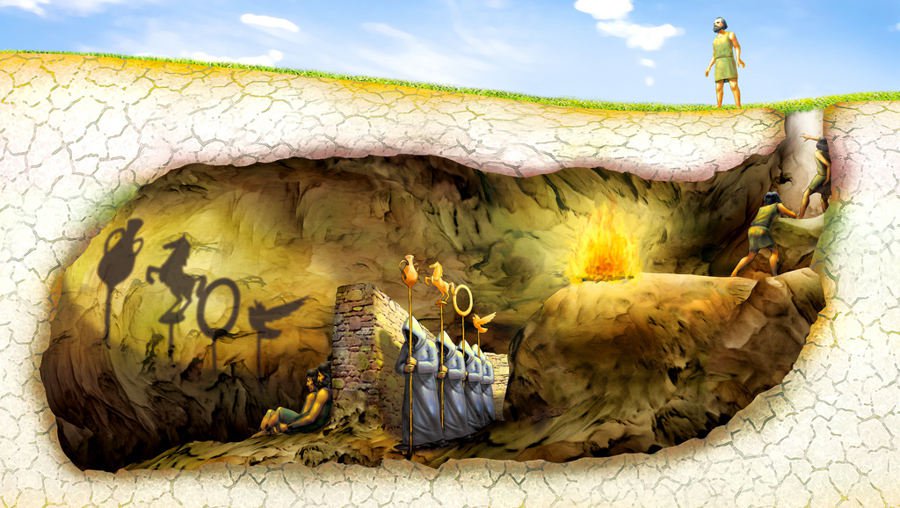
Engem márpedig az ideák jobban érdekelnek
„Ismerd meg önmagad” – nincs új a nap alatt Szókratész mester óta sem. A tény, hogy e mondatát az isteneknek tulajdonított jóslatok szent helyének bejáratára írták fel, megint csak valamiféle eredendő alagútra mutat rá vallás és tudomány között. Ma is az önismeret elsődlegességét hangsúlyozza a lélektan, ahogy a spirituális kibontakozás is az önmagunk benső lényege felé való fordulás útján valósulhat meg. A Camino egy komplex önismereti terápia: sokkal fontosabbnak tartom annál, mintsem hogy szimpla turisztikai látványossággá váljon…
Erre itt van velem valaki, aki csak utazgatni akar. Ahogy szokott – szóval tulajdonképpen a komfortzónáján belül.
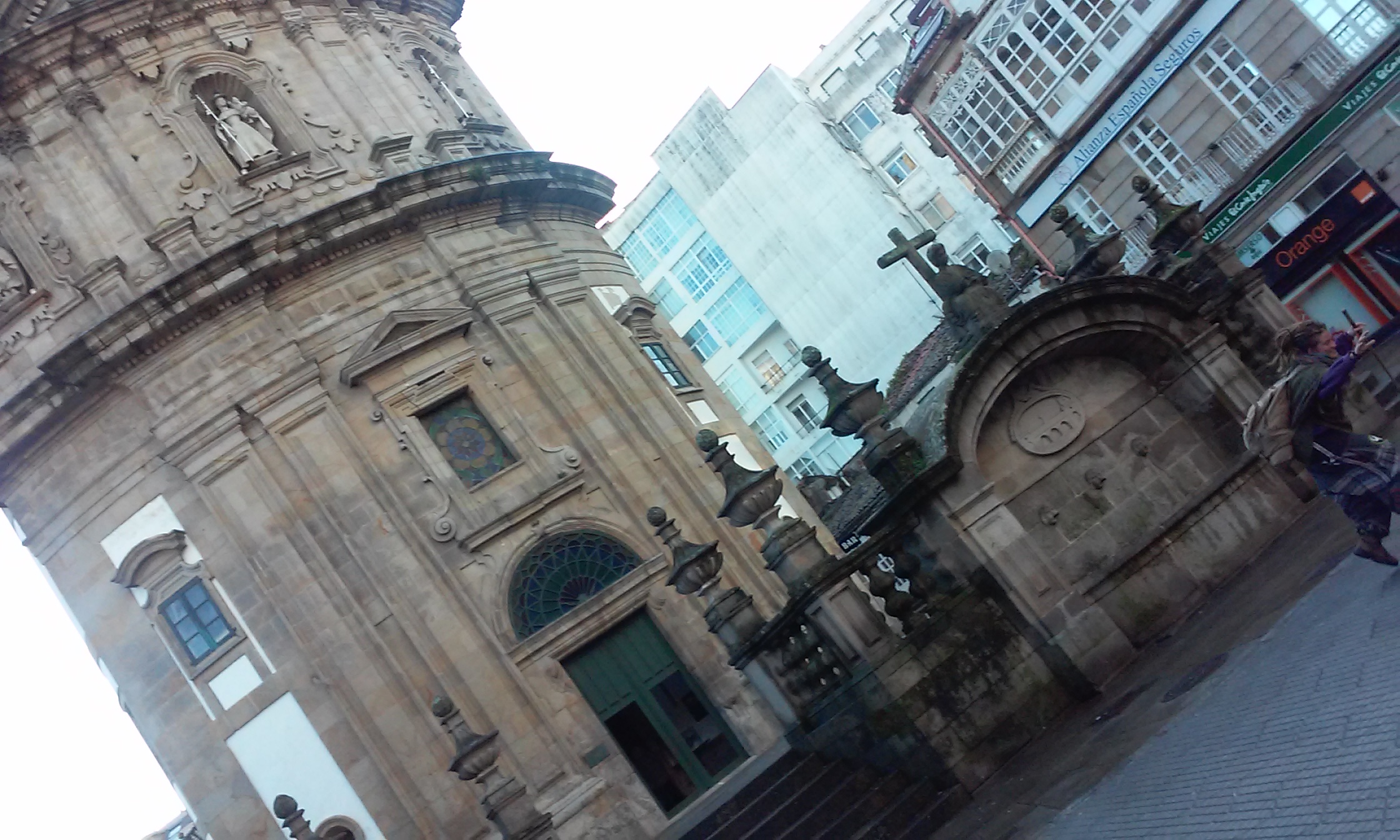
La Peregrina (azaz "a zarándoknő":)) kápolna, Pontevedra
A komfortzóna elhagyásának legtöbbek számára elengedhetetlen része az egyedüllét. Sokan alapból nem tudnak egyedül lenni – elunják magukat, rosszabb esetben magányossá, hosszabb távon akár deprimálttá válnak. Be kell látnunk, kisebb-nagyobb részben másoktól várjuk az örömeinket. A fejlett személyiség jól érzi magát egyedül is, avagy úgy érzi csak igazán jól. Az emberi kapcsolatok is az önismerettel kéne, hogy kezdődjenek.
Bennem maradt Szabó Csaba előadásából egy gondolat, ami nem szerepel a cikkben: a Caminon mindenki egyedül van. Akik együtt indulnak, azok is el-elhagyják egymást, más tempóban mennek, más helyeken szeretnek elidőzni, és így tovább. Azóta sok minden változott (ő még e 2008-as tanulmányban évi 70 ezer zarándokról ír, ez a szám 2016-ban már 280 ezer volt, még ha ezek jó része csak 100km-t is gyalogol!), de azóta is úgy gondolom, hogy egy spirituális zarándoklat eredendő céljai között szerepelnie kell ennek a fajta esszenciális, önismereti egyedüllétnek.
Hát, ezúttal semmi ilyen nem adódott.
Csengének sem, de benne szemmel láthatóan igény sem volt rá. Külföldre mindig haverral megy, aki beszéli helyette a nyelvet – ez lennék most én. Rend szerint stoppolással változtatnak helyet – ez is több szakaszon befigyelt most a portugál gyalogúton. Mindig jó okkal, és nem is gondolnám „csalásnak” – mondom, nem teljesítménytúra ez. (Főleg, hogy a szamárral ilyesmire évekig még lehetőség sem lett volna, ahogy ezután a portugál kiruccanás után sem lesz már többé.) A bajom inkább az volt, hogy egy pillanatra sem éreztem magam egyedül – holott eredetileg ez (is) lett volna a cél.
Már ennél is jobban szerettem volna, hogy Csenge – avagy a külföldiek által ejtve Dzsenga – legyen egyedül egy kicsit az úton. Sok nő megy fizikálisan is magában, még nála fiatalabbak is – a Camino tök biztonságos... Hát… végülis Dzsengával nem is történt semmi baj. Csak énvelem.

Márc.2-i időjárásjelentésünk egy albergue-vendégkönyvben
Véletlenek, mint tudjuk, nem léteznek. E nem létező dolgok sorozata ezúttal ott kezdődött, hogy egy kedves, régi zarándoktársam, Szilvi rám írt pár javaslatot, amikor megtudta, hogy a portugál úton vagyok, mivel ő azt már korábban megjárta. Útikönyvem nem volt, olyasmiket a kezdetek óta nem használok, mert ezek leginkább turistakalauzok – ezt az aspektust továbbra sem erősíteném. Szeretem viszont megfogadni a régi és új ismerősök tanácsait, úgyhogy megmaradt bennem, hogy Pontevedra után a Camino Espiritual alternatívát válasszam a kétfelé ágazó úton, mert az majd nagyon jó lesz nekem.
Pontevedrába érkezve egy elhagyott ház fedett udvarán háltunk masszázságyon (értsd: hullámpalákon), ahol a dekoratőr alvóhelyrendezés során ismét feladta a többszörösen talpaltatott cipőm. Cseréről szó sem lehetett; úgy hozzám nőtt ez a futócsuka, hogy velem fog a sírba szállni. Városban vagyunk – reggel végre ellőhetem minden spanyolkurzusok első példamondatát: ¿Dónde está la zapatería? (Hun van a suszter?)
Közös pontevedrai veszteglés nem jöhet szóba, mert közben letisztázódott egy találkám időpontja régi, egyetemi évfolyamtársammal. Katival a filozófia szak elvégzése óta nem is találkoztam, de mostanában váltottunk pár levelet a Camino meg a blogolás kapcsán, amiben a kezdetekkor egy csomót segített is a tanácsaival. Szóval mindenképp szerettem volna összefutni vele, főleg, hogy már régóta megígértem, és ő is régóta szervezgette a hosszúhétvégéjét Santiago-Fisterra vonalon. Dzsenga jól előremegy, én meg keresek egy cipészt, és megvárom a procedúrát; este találkozunk Caldas de Reisben, ha már alapból úgyis gyorsabb vagyok... ahogy én azt elképzeltem.
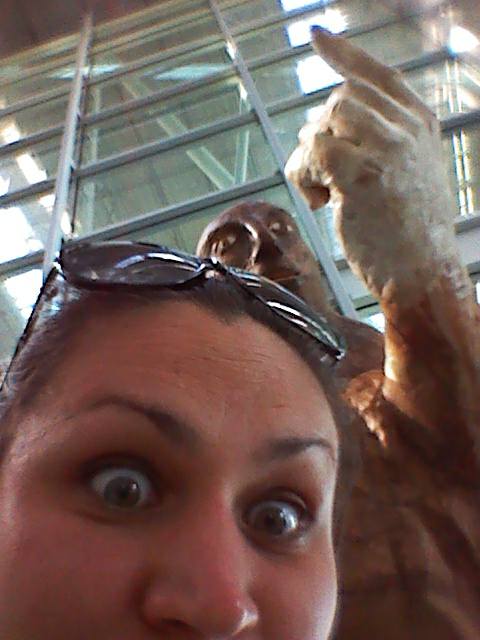
Kati a santiagoi reptéren… Ő nálam szorgalmasabban fényképez – meg fogok majd osztani egy válogatást a galiciai képeiből!!
Erre az első szembejövő ember a példamondat-kérdésre csak egy laza kézmozdulattal átbök az út másik oldalára: ott volt egy cipész egyből. Bementünk, és azonnal megreparálta a surranót valami 3 euróért (mennyi erre az esély?! abban sem voltam biztos, hogy léteznek-e még egyáltalán suszterek...), és még könyvet és prédikációs CD-ket is adott lelki útravalóul a zarándoklatra – csak hogy még nehezebb legyen a tatyó. Nem oszt nem szoroz, így is teknősbéka üzemmódban voltam: hátamon nagytáska a ruhákkal, hasamon egy kisebb a számítógéppel meg a pénzünkkel, ami ismét csak egy csomó véletlenen keresztül (most hosszú lenne elmesélni) épp teljes egészében kápéban volt nálunk. Nyilván.
Így még délelőtt el tudtunk indulni, és nem váltunk szét. Pár kilométer után sorsszerűnek éreztem a táblát: „Ruta alternativa: Variante Espiritual”. Áh, el is felejtettem. Ezt emlegette Szilvi! Csakhogy ez az út napokra elhagyja a hagyományos portugál caminot, és Padrónig kétszer olyan hosszú. Nézegetjük a táblán a térképet, számolgatjuk az időt– a népzenei megoldás kézen fekszik: indulj el egy úton, én is egy másikon. 36 km Padrónig két laza nap, nekem viszont komoly kihívás lesz ugyanannyi idő alatt 74km-t zúznom a spirituál úton. Hú, de kafa lesz! Majd Padrónban könnyed hangulatú, derűs hittanóra keretei között jól megbeszéljük a kalandjainkat… izzott bennem a szunnyadó pedagógus, hehe. Meg a szintén szunnyadó zarándok is.
A nettó 20 perc alatt, amíg átszerveztük hátizsákjainkat, egyetlen autó sem ment el a kereszteződésnél, ahol az út kettéválik. Pompás izgalommal indultam balra, míg Dzsenga jobbra. Vagy 150 méterre lehetett tőlem, amikor eszembe jutott, hogy a telefontöltője nálam maradt. Nem mintha a zarándoklat szerves részét kéne képeznie a telefonhasználatnak: legvidámabb időszakaim, amikor nincs nálam ilyesmi, és azt sem tudom, hogy mennyi az idő. De nyilván mocorgott bennem egy kis félsz, hogy ha bármi nem úgy alakul, akkor tudjunk kommunikálni. Lehajítottam a nagytáskát, és – szerintem életemben először – mellé a kicsit is, hogy kiabálva utánarohanjak a töltővel. Ekkor a kanyarban befarolt egy fehér kocsi (ennyi idő elteltével a legelső az úton), és állati ellenszenves módon kiordítottak belőle valamit, hogy hova rohanok az út közepén. Átdobtam a töltőt, és futottam is vissza a táskákhoz – azaz hát a hűlt helyükhöz.
Csak a botom árválkodott. A démonkocsi elvitt mindent. Nagyjából fél percre maradtak őrizetlenül a táskák. Fehér Ford Focust keres a rendőrség. (Áh, hagyjuk már, dehogy keresi.) Ketten vagy hárman ültek benne. Fiatalok.

...Továbbra is háromszor voltam zarándok a Caminon, viszont remek rendőrséges és hajléktalanszállós sztorikkal gazdagodtam. Ezek (is) fognak következni a második részben, zászlónkra tűzve a Galaxis útikalauz stoposoknak elsődleges tanácsát: Ne ess pánikba.
------------------------------------------------------------------------------------------------
EN:
I don't know the answer. But I can tell you what I did... Today is the blog's first birthday. Let's celebrate with a big party unexpected complications and solutions on the Camino Portuguese.
In Part 1 I tell you about how psychological factors turned into an absurd and unlikely situation, by which all my money and stuff’s been gone. Part 2 is going to be more practical and mundane: The solving process of the case through the introduction of the – often equally absurd – mazes of the local law enforcement measures and social supply system.
Many people have asked me how many times I’d walked the Camino. At first I considered it a silly question, although – as we already know from my pedagogy role model Mr. Garrison – there’s no silly question, only silly child. I answered that I don’t count, just walk. Neither do I collect stamps in my pilgrim passport – all in all, I’ve got just one single Compostela, which I recieved when first arriving in November 2013. (Then I asked only once more in the end of 2015 in the name of my 90-year-old grandma; as the certificate can be offered to a person who’s dead or is not motile, i.e. wouldn’t be able to accomplish a pilgrimage.)

Years after the first arrival was taken the first photo of us here... It's said to be a church under this racking system!
Reconsidering the thing, I don’t think the question silly and I even have a specific answer to it: I’ve done the St. James Pilgrimage 3 times so far in my life. (And when-from where-until when-where, see HERE: the points I.1-7., II.2-3. and III.1.) ... Yes, I’ve arrived more times on foot to Santiago de Compostela from more than 100 km, but it was 3 times that I really felt like a pilgrim.
This feeling seems to be independent from my intentions, I just fall into it somehow, but one thing is sure: one important ingredient is leaving the comfort zone. As my whole lifestyle changing process is connected to this route, I can’t always be a pilgrim here, since this way have I made as my comfort zone.

As I was preparing myself for Rocinante’s retiring home-walking (Muxia-Santiago-Lourdes-Rome-Assisi-Medjugorje-Budapest-Szentendre line in two parts, 2 times in approx. 5 months each time), a need for a 4th camino was growing in me, with the need for recharge with spiritual donations to be amplified and passed on. I wanted to start this seemingly endless nomad mission cheered-up and tuned on.
Being outside the comfort zone would have been given by the serene Portugal as a new country for me, and also the lack of the donkey, i.e. the total solitude of February – as I’ve imagined. However Csenge appeared as my partner for the home-walking with Rocinante, which I was very happy about ‘cause the double-5 months-solitude scared me a little. The circumstances told us to go to Porto to start pilgrimage together too. So at first, she will also look at the Way through the eyes of the pilgrim: towards the normal direction, without donkey-support. We arrived to the city at the 19th February.
The feeling of pilgrimage didn’t come in Portugal… As I told you, it’s independent from my intentions. In return, many other things came, and it was totally cool! Just it wasn’t the St. James pilgrimage.
I tell you about it.

Camino Portuguese map and the Galician part (from the wall of the Albergue Municipal of Pontevedra)
We walked with a pile of stuffs – for practical reasons, again. But we are pretty hardcore, so we dealt with the problem… I tried to put this and that to the Facebook page of this blog, e.g. our hikings with the recycled stroller, when it was me who became a donkey for a few days:
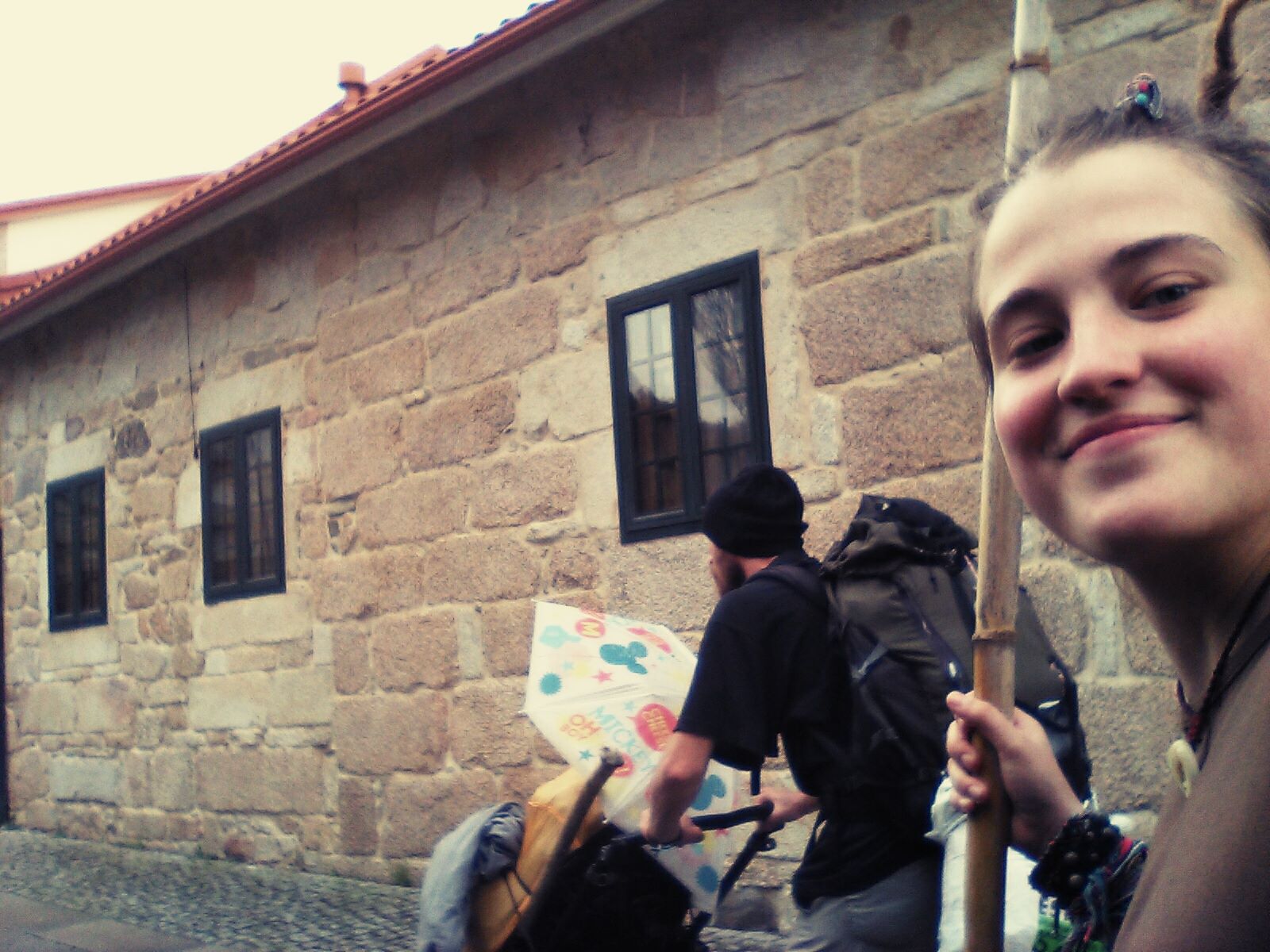
Actually, the demand has been conceptualized already in Porto that if our stuffs would be stolen and then we could freely run around: At the station, a local homeless showed us a particular luggage locker to put our bags in and so did we do. After that we were thinking why this torn, stinking old man was so nice – he may know the way that locker opens?! No, he seemed to help us selflessly; “unfortunately” we were able to put our loads back on, in complete.
But the Way provides, as they say; however, you don’t know when, what and how it provides to whom... I continue the story.

Vinho do Porto, light-heartedness
We arrived in Spain relatively smoothly in our low budget way, except of a conflict between us, which seems important regarding the upcoming events. Namely, my priority is to always highlight the religious-spiritual side of the Camino opposed to the tourist and performance tour side of it. St. James’ way has its renaissance nowadays, and so it seems to have less and less connection to St. James himself... And what is: according to Csenge, the whole Camino is a fake, a kind of a placebo.
Because, in Budapest her life’s similar to this route. She doesn’t watch TV. She has very few stuff. If it turns so, she’s just walking all day long. If it turns so, she’s hanging out with strangers like they were friends for ages. If so, she’s sleeping in a park, etc. She’s being random and continuously experiencing things like pilgrims here, considering them “miracles” and awareness raising, important events of their lives.
How do you introduce someone the spirituality of Camino who actually has it as her comfort zone even at home? „Camino de la Vida”, or as French says… it says somehow.
This is a very interesting question, about which I had many conversations with pilgrims. Is it possible to reach this spiritual development anywhere, which people are talking about, or is there truly a transcendent, elusive „magic” in the walking of ways leading towards Santiago?
After being here, talking and thinking a lot I concluded from my part that it’s so-so.
Psychological factors stemming from leaving behind civilizational routines are important – mainly this is summarized in the article written by one of my teachers, Csaba Szabó (actually from him I heard about the Camino first, which he walked in 2007). But there’s also one part of the tradition, which is not possible to research from scientific perspectives and the usual methods ‘cause it goes far beyond, or at least far away from them – it belongs under the authority of faith and religion. In fact, this could be an endless topic of discussion promising no final solution in the axis of science and religion, but good news that there’s passageway between the two sides: just read into the relevant works of the archetype of the great spiritual-perspective scientist C.G. Jung, or the contemporary big shot Ken Wilber. (And it’s not to be replaced by the fabulous dribbler writings of the nowadays fashionable pop-spirituality, despite – or because of – the fact that those are more comfortable to our ego to identify with.)
This conviction of mine is confirmed only by my inexpressible experiences, and my belief stemming from it.
There was e.g. that case when my first pilgrimage, in the autumn of 2013 – according to the tradition – I did the usual ritual at the iron cross on the highest point of Camino Francés, at the Cruz de Ferro, then walked on as if nothing happened. Next day a local lad told me that the cross is there only since the 1970s when the camino was led there due to the construction of the main road next to it. He explained the original, old place of the Cruz de Ferro where pilgrims have brought the stones symbolizing their psychological burdens for decades, where they could get rid of them. We went there with my two newfound companions; there is already no cross, only a pile of stones. We got on top of the stones, and for about half an hour none of us spoke. We fell into meditation spontaneously, without any visible external causes. We all experienced that things here work otherwise, something had happened here; this place has a soul, which is now pervading us… It sounds silly, right? Of course, ‘cause language is a silly thing: human found it out, not God.
Or there’s that other story when I incidentally piss-crapped into the brook of Lavacolla. As profane and ridiculous the story seems from the outside, the inside concerned me at least as deeply - I wrote about this story earlier: CLICK.
Both Cruz de Ferro and Lavacolla are ritual places of St. James way, things I experienced here couldn’t have happened anywhere else. In connection with the way people talk about the Earth’s magnetic lines, the trail of stars followed by the Celts, the Milky Way (back then they moved from west to east on the same way), and many other things, but possible explanations at least partially always avoid the domain that can be totally examined by science.
Science is inherently finite, however, religion penetrates to infinity through the subjective way of experience. (That’s why I consider it short-sightedness when people of the age make science their factual religion.) Camino can provokate God experience, and this process can be a subject of objective examination, but not the subjective personal experience itself. We can even see what’is happening in the brain and how this changes behavior, but the substrate of the experience, the essence of the whole we can’t. To live with the cave metaphor of Plato: the shadows we can get to know this way, but not the ideas.
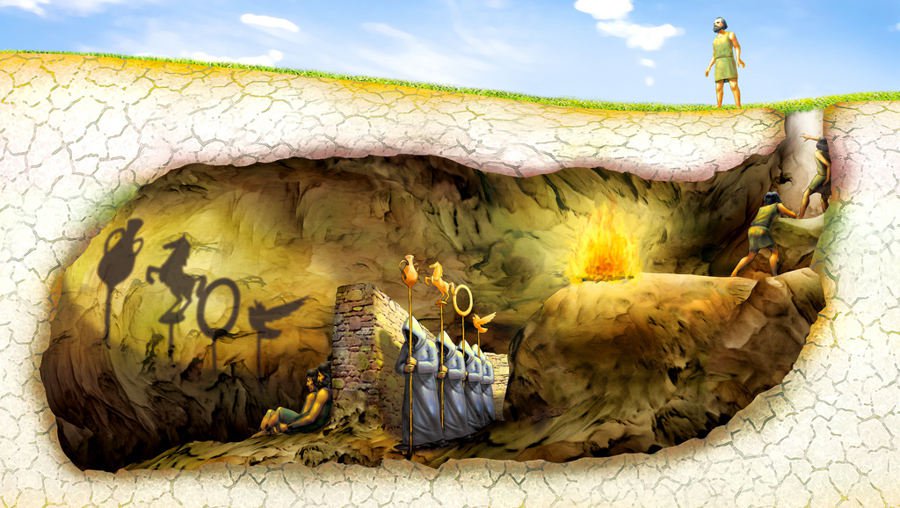
Anyway, I’m more interested in the ideas
„Know thyself” – there’s nothing new under the sun even since Plato’s master, Socrates. The fact that this sentence of his used to be written at the entrance of sacred place of predictions attributed to the gods, again shows only some inherent relationship between religion and science. Psychology also highlights the priority of self-knowledge nowadays too, as spiritual unfolding can also be realized through turning towards the essence of our inner self. The Camino is a complex self-knowledge oriented therapy: I see it more important rather than to become a single tourist attraction…
And so there’s somebody with me who just wants to travel. Like she used to be – that is, inside her comfort zone.

Pontevedra, La Peregrina chapel with the peregrina herself
For most of the people, an essential part of leaving the comfort zone is solitude. Many of us basically can’t be alone – they get bored, in worse cases they become lonely, or even depressed in longer term. We have to admit, more or less we expect our pleasures to come from others. The developed personality, however, feels good alone as well, indeed, it feels the best alone. Human relations should begin with self-knowledge too.
From a presentation of Csaba Szabó a thought remained in me, which is not included in his article: on the Camino everyone is alone. Even those starting together, they leave each other, walk at different speed, like to stay at different places etc. Since then, many things have changed (his 2008 study writes about 70 thousand pilgrims annually, which number grew to 280 thousand since then, even if the big part of which only walks 100km!), however, I still think that the aims of a spiritual pilgrimage should include this kind of essential self-knowledge oriented solitude.
Well, this time I haven’t experienced it at all.
Neither has Csenge. But, noticeably, she had no need of it. She always travels abroad with a buddy who speaks the language instead of her – this would be me this time. They regularly move place by hitchhiking – this also happened on the Portuguese way. Always with a good reason, and this I wouldn’t consider “cheating” this time – I tell you, this is not a performance tour. Mainly, that I wouldn’t have had the opportunity for it with the donkey as companion, like there won’t be any more after the Portuguese fun. My problem was rather that I never felt alone, not even for a moment – although this would have been originally the goal.
By this time I wanted it even better that Csenge – or Jenga, pronounced by foreigners – should finally be alone a bit on the way. Many women go alone, sometimes even younger than her – Camino’s totally safe... well, after all, there happened nothing with Jenga. Just with me.

Our weather forecast to 2nd March in an albergue's guestbook
Coincidences, as we all know, don’t exist. The series of these non-existent things began with Szilvi, a nice old pilgrim mate of mine, wrote me some suggestions when she got to know I’m on the Portuguese way, ’cause she’d already done it. I had no guide book; I don’t use this thing from the very beginning, as they are more like tourist guides – I wouldn’t strengthen this aspect this time either. However, I love to heed the advice of old and new acquaintances, so the sentence remained in me that after Pontevedra I have to choose the Camino Espiritual alternative at the bifurcated way ‘cause it will be good for me.
Arriving to Pontevedra, we slept in an indoor courtyard of an abandoned house, on a massage bed (that is, on corrugated sheets), where my multiple re-soled shoes gave up during the organization of the sleeping area. No exchange – I had that symbiotic connection to these shoes that it will come to the grave with me. We’re in a town – in the morning finally I will have the chance to exploit the first example sentence of any Spanish language courses:¿Dónde está la zapatería? (Where’s the shoemaker?)
There was no question of wastin time together in Pontevedra because meanwhile the date of my meeting with an old university mate became clear. I haven’t met Kati since the completion of philosophy major but nowadays we’ve exchanged several letters again in connection with the Camino and the blogging, regarding which she’s helped me a lot with her advices at the beginning. So I wanted to meet her for a long time, mainly, because I promised it long ago, and she’s also been planning a long weekend on the line of Santiago-Muxia-Fisterra. Jenga will proceed a lot and I’ll search for a shoemaker and wait for the procedure, and we meet up in Caldas de Reis – as I imagined, since I’m basically faster than her.

Kati at Santiago airport… She’s more hard-working in making photos – I’m going to share a selection of her Galician pics!
In turn, the first crossing-by man pointed to the other side of the road: there was a shoemaker right there who immediately repaired my shoes for some 3 Euros (how are the odds for this?!), and so he gave us a book and CD-s of preaching’s as well, as spiritual sacrament for the pilgrimage – just to have a heavier package. It doesn’t make any difference, I was already in turtle-mode: a big backpack with clothes on my back, plus there were thing hanging on my belly too: a smaller computer and our money, all of which was in cash, again due to a lot of coincidences (for now, it would be a pretty long story). Obviously.
So we could start off still quite early in the morning, and again, we didn’t separate. After a few kilometers I felt the signpost as fate: „Ruta alternativa: Variante Espiritual”. Ah, I already forgot it. This is what Szilvi mentioned! There was one thing she didn’t: this way skips the traditional Camino for days and twice as long till Padrón. We are looking at the map on the post, counting the time – the solution from the folk music seems obvious: „Get started on one road, I take the other one”. 36km till Padrón is 2 lazy days, however the 74km will mean a hardcore gallop for me during the same period of time on the spiritual way, I could hardly wait. Then we will talk about our adventures in Padrón, within the framework of an old-fashioned religion course… the sleeping pedagogue was glowing in me, hehe. And of course, so did the sleeping pilgrim!
While the 20 minutes that we reorganized our backpacks, no cars have passed the crossroad where the way splits in two. I set off to the left in cheerful excitement, while Jenga took the right. We could have been some 150meter far from each other when I realized that her mobile charger remained with me. Not that telephone usage should be an integral part of the pilgrimage: most cheerful periods were without these kind of things, not even knowing what the time is. But I was a little afraid that in case anything happens we should be able to communicate at least. I threw the big backpack, and – I think first time in my life – also the little one next to it, so that I run after her with the charger shouting hard. At this point a white car stopped at the corner and shouted something like where I am to run in the middle of the road, saying it in a roughly distasteful manner. I threw the charger over and ran back to the packages... or rather to their empty place.
Only my stick stood there alone, the demon car took everything. The packs were left unguarded for about half minute. The police investigates for a white Ford Focus. (No, I don't think they investigate for anything on the case.) There were 2 or 3 persons in the car. Young people.

It’s still true that I completed only 3 pilgrimages on the Camino, however I enriched with great police and homeless-shelter stories this time… These will follow in the 2nd part, setting the primary advice of Hitchiker's Guide to the Galaxy on our flag: Don’t panic!
